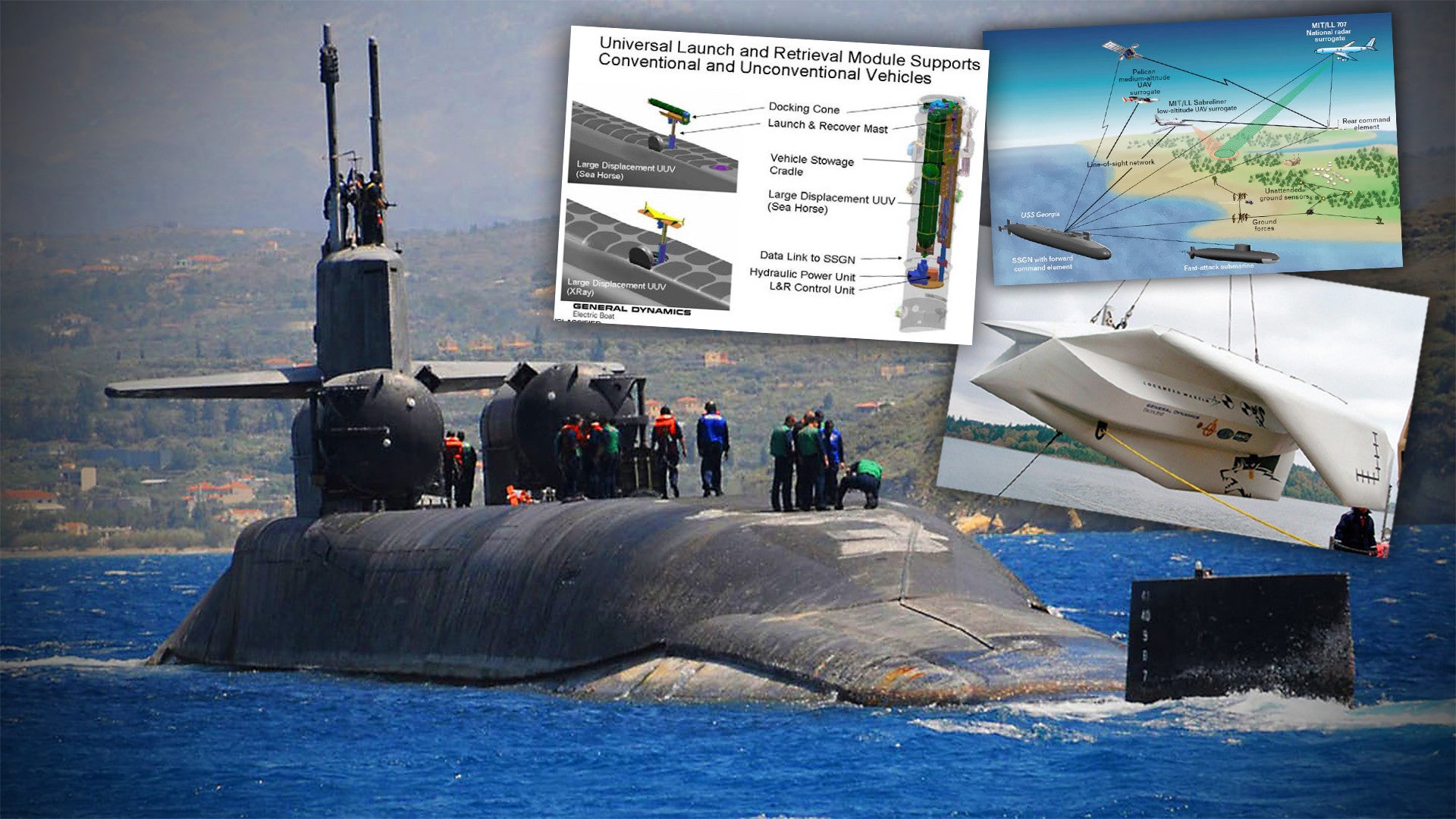Today, the U.S. Navy’s quartet of converted Ohio class nuclear-powered guided-missile submarines, or SSGNs, are among America’s most powerful, in-demand, and flexible weapons. These giant and secretive submarines are known for their ability to carry up to 154 Tomahawk land-attack cruise missiles and dozens of special operations frogmen into contested territory to ply their quiet trade, but really, they are much, much more than that.
A decade and a half ago, the U.S. Navy was testing incredible new capabilities that it would subsequently integrate into its four yet to be converted SSGNs, including one highly elaborate, but obscure proof of concept exercise that solidified the SSGN concept for the seagoing service. Here is the story of how these vessels came to be and the highly unique, if not exotic capabilities, from drone mothership to command and control center, they possess.
The Genesis of the Ohio SSGN
The decision to covert Ohio class SSBNs into SSGNs originated with the 1994 Nuclear Posture Review, which determined that only 14 of the 18 Ohio class boats were necessary to meet the United States’ nuclear deterrence needs. Eight years later, the Navy began actually converting the four oldest Ohio class submarines – USS Florida, USS Georgia, USS Michigan, and USS Ohio – into the new configuration.
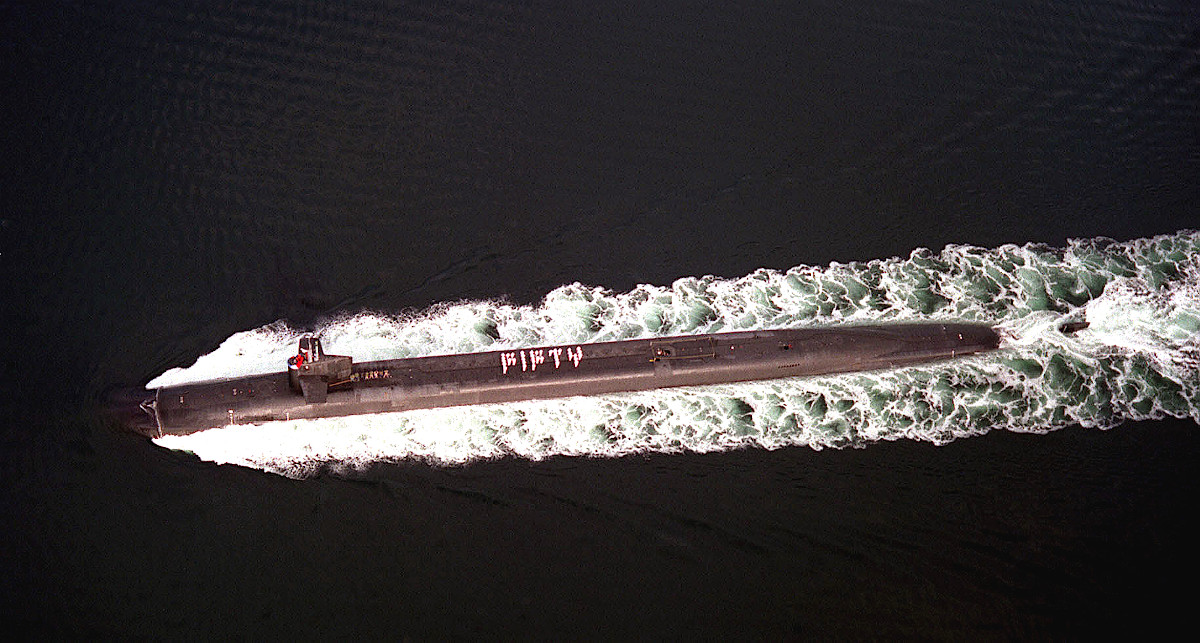
The Navy had considered a number of potential configuration options for the new SSGNs. The concept that the service finally settled on retained 22 of the 24 missile tubes found on Ohio SSBNs, but modified them so that they were unable to fire Trident D5 nuclear-tipped submarine-launched ballistic missiles (SLBMs). Instead, each one would be able to launch up to seven BGM-109 Tomahawks using a Multiple All-Up-Round Canister (MAC) adapter. The SLBM fire control systems were similarly replaced with ones for the Tomahawk.

Tubes one and two on each of the four SSGNs would be completely replaced with lockout chambers so combat divers and Navy SEALs could enter and exit the submarine underwater. Personnel could also install a Dry Deck Shelter (DDS) to the top of the hull linked to either one of these modified tubes, or both if required, which could accommodate swimmer delivery vehicle (SDV) mini-submarines. As the name suggests, the DDS provides a fully enclosed, dry space to work in on the submarine’s deck, even while it is underwater.
ABC News’ David Muir just recently got a chance to go aboard the USS Florida, providing a behind the scenes look at the interior of one of the converted SSGNs in its present configuration, which you can see in the video below.

The abortive Advanced SEAL Delivery System (ASDS) was supposed to have been able to directly dock with either one of these lockout chambers, as well. The Navy canceled the ASDS program in 2009 after cost overruns and other major setbacks, including a fire that had destroyed the original prototype the year before.
With a DDS installed, a number of additional tubes on the SSGNs would also be blocked off, so the Navy decided to make tubes three through 10 reconfigurable into storage space, if necessary. A dedicated berthing area for a typical contingent of 66 special operators, with a surge capacity of up 102 personnel, was added in the reconfigured missile compartment, as well.
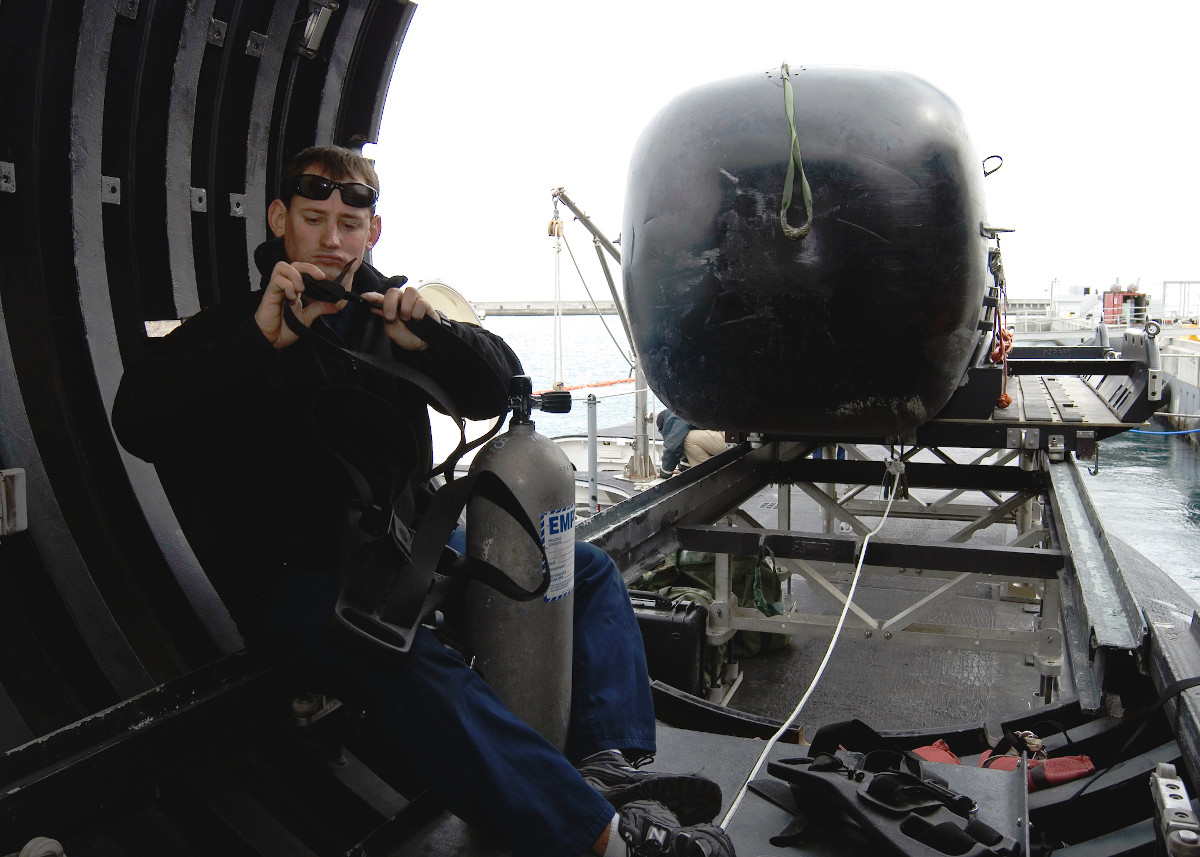
More recent reporting has indicated that a typical load for these submarines is around 100 Tomahawks. This most likely represents between 14 and 16 fully loaded tubes, which would equate to between 98 and 112 missiles in total. This would leave between six and eight tubes available for storage or other purposes, something we will come back to later on in the story.
Beyond that, the SSGN configuration had an all-new a dedicated special operations mission control center and associated mission planning spaces. It also included additional and improved sensor and communications antenna masts on the sail. Other modifications that would allow these submarines to better operate in shallower waters closer to shore, were also likely involved with the conversion.
A rich history of special mission submarines
The Navy had substantial past experience with employing submarines as special operations motherships and in the tactical strike role, to say nothing of using them as specialized covert intelligence gathering platforms, when it had crafted the requirements for the Ohio SSGNs. The ability of a submarine, in general, to transport personnel and materiel, as well as launch raiding parties ashore, while using its inherent capabilities to help avoid detection, was well established by the end of World War II.
Between the mid-1950s and early 1960s, the Navy, in cooperation with the Central Intelligence Agency (CIA) and U.S. Air Force, had even used submarines to secretly launch radar-reflecting balloons to probe hostile air defense capabilities. You can read more about these operations in this past War Zone story.
By the Vietnam War, the Navy was using specially configured submarines to support special operations. These included Gato class USS Tunny and the first-in-class USS Grayback, both of which were diesel-electric submarines that had previously been configured to fire the Regulus nuclear-armed cruise missile.
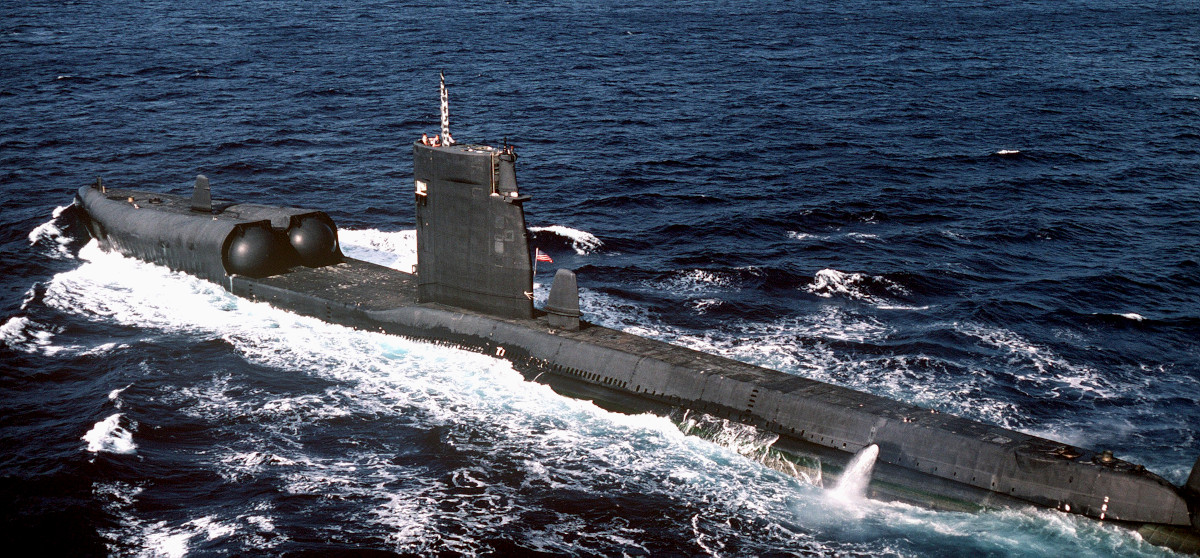
The “hangars” on the decks of these submarines for the airplane-sized Regulus were well suited to modification into lockout chambers for swimmers and shelters for mini-submarines, just like the Ohio’s Trident tubes. In 1968, the Navy went so far as to designate them LPSSs, or amphibious transport submarines.
These boats supported special operations along the coast of North Vietnam and also helped gather intelligence. Grayback was notably involved in Operation Thunderhead in 1972, an attempt to rescue American aviators that the U.S. military believed had escaped from North Vietnam’s infamous Hanoi Hilton prison. Bad weather and other factors eventually led the Navy to abort the mission and SEALs and Underwater Demolition Team (UDT) members never made contact with any escapees.
One SEAL, U.S. Navy Lieutenant Melvin Spence Dry, died during the mission. The U.S. military only acknowledged the operation in 2008, at which time Dry received a posthumous Bronze Star.
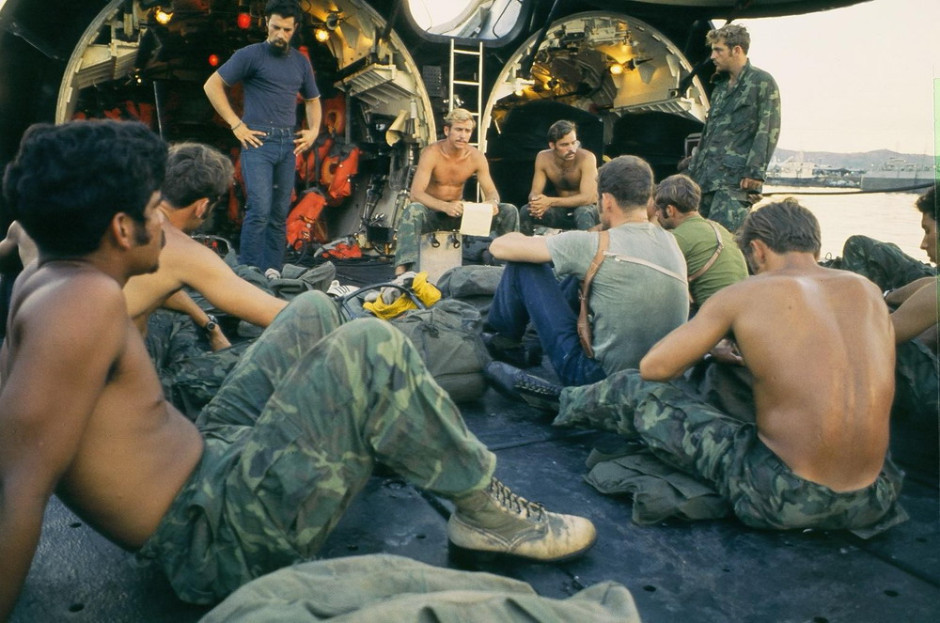
In the decades after Vietnam, a number of Sturgeon class nuclear-powered attack submarines also served in similar special operations support roles. In something of prelude to the Ohio SSGNs, as part of the Strategic Arms Limitation Talks, or SALT I agreement between the United States and the Soviet Union in 1981, the Navy disabled the SLBM capabilities on a number of SSBNs, reclassifying them officially as attack submarines.
USS Sam Houston, USS John Marshall, USS Kamehameha, and USS James K. Polk – the first two belonging to the Ethan Allen class and the latter pair being from the Benjamin Franklin class – received further modifications that added DDSs to the top of the hull and dedicated spaces to carry embarked SEAL teams. These submarines continued sailing into the 1990s and Kamehameha was the last to leave service, with the Navy only decommissioning her in 2002.
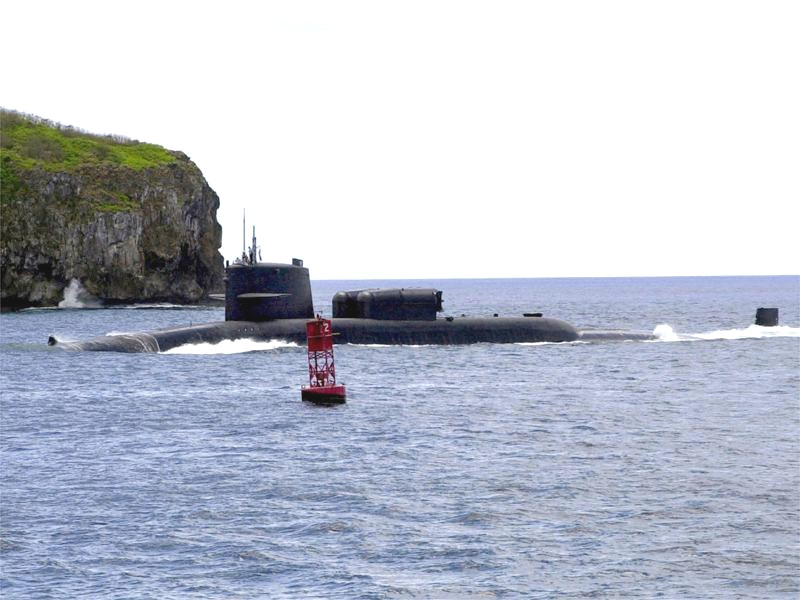
A new kind of submarine mothership
Still, while the Navy had decades of experience with using submarines to support tactical operations, including special operations, at sea and onshore, the Ohio SSGNs aimed to be far more robust and flexible multi-mission platforms than any of these previous conversions.
As of 2004, the service was still very much fleshing out the specifics of the SSGN conversion and “writing the manual” on how to then employ these submarines. Georgia had become the main testbed for what was still very much an evolving concept, receiving a number of interim modifications including reconfigured internal mission spaces and additional data links and communications equipment. At that time, none of the four chosen Ohios had gone through the full conversion process and they were still years away from actually entering service in their new configuration.
“Two years from now, when we open the wrapping paper to see USS Georgia, a brand-spanking-new SSGN, we are going to need an instruction manual,” U.S. Navy Commodore Robert Shuetz, then-commander of Submarine Squadron 17, said at a change-of-command ceremony for the submarine in December 2004. “A manual that hasn’t been written yet; a manual that will describe in excruciating detail how this new ‘toy’ will be operated.”
“This is where the crew of Georgia has excelled,” Shuetz continued. “They have written the first instruction manual for how this ship and her three sisters, the ‘toys’ in demand by every combat commander, will be operated.”
Silent Hammer
Two months earlier, off the coast of San Diego, California, Georgia, even without anything near the full suite of capabilities outlined in the conversion plan, had demonstrated just what the SSGN configuration might be capable of as part of an experiment nicknamed Silent Hammer. To enhance the realism of the scenario, the Navy inserted this test into a larger exercise, called Trident Warrior, that involved an array of other submarines, ships, aircraft, drones, and special operations forces (SOF).
The Silent Hammer scenario, which lasted a little over a week, involved a joint task force with Georgia in the lead locating and neutralizing mock terrorists on land and at sea. The “red team” occupied various sites on San Clemente Island, situated some 80 miles west of San Diego, which the U.S. military routinely uses for exercise and other test purposes. The contractor-operated offshore support vessel, the R/V Acoustic Explorer, also served as a simulated maritime threat.
The overall objective of the exercise for the “blue team” was to find and fix these faux militants using a variety of intelligence sources and then neutralize them with simulated Tomahawk strikes.

During the experiment, at least publicly, the focus was far more on the submarine’s ability to act as an intelligence-collection platform, as well as a broader “clandestine sea-base” that would provide a “headquarters node from which command and control operations and logistic support were conducted,” including for special operators ashore.
“Our converted Tridents will generate their own intelligence, which allows onboard commanders to make decisions about what’s needed and determine what additional organic sensors should be deployed in virtually any scenario,” by-then-retired U.S. Navy Admiral Frank “Skip” Bowman wrote, referring to the Ohios collectively by the Trident submarine-launched ballistic missiles that the SSBN versions carry, said in the Winter 2005 edition of Undersea Warfare magazine, the official publication of the U.S. Navy’s Submarine Force. Bowman’s last position in the service had been as Director of Naval Nuclear Propulsion.
“Silent Hammer demonstrated how a networked force, including sea-based SOF from an SSGN, can fill joint gaps – Intelligence, Surveillance, Reconnaissance (ISR) and Time Sensitive Strike – by conducting large-scale clandestine operations, supported by advanced unmanned systems, to reduce risk and increase capability,” U.S. Navy Captain J.S. Davidson, who headed up the Silent Hammer experiment, had explained in another interview for another story in that same issue of Undersea Warfare.
An intelligence nerve center
It’s hard to overstate how significant the intelligence fusion capabilities demonstrated during Silent Hammer were. For the experiment, Georgia had an embarked joint service command team onboard, who used modified spaces in the submarine to run a forward operations center that controlled other assets under the waves, riding on the surface, in the air, and on land. This was intended to reflect the capabilities that the submarine would have after going through the SSGN conversion, which would create new, more robust mission spaces for command and control elements and intelligence gathering personnel, among others.
This was the first time the Navy had ever done this as part of the development of the SSGN concept of operations and it put the operational commanders right in the thick of things in a whole new way. Unlike traditional surface command ships, such as the USS Blue Ridge, the Georgia was allowing these officers and their staff to direct forward operations while sailing concealed below the surface of the ocean. The submarine’s command center was linked to rear command centers, and their intelligence networks, via satellite. It also had direct data-link feeds from a number of other sources.
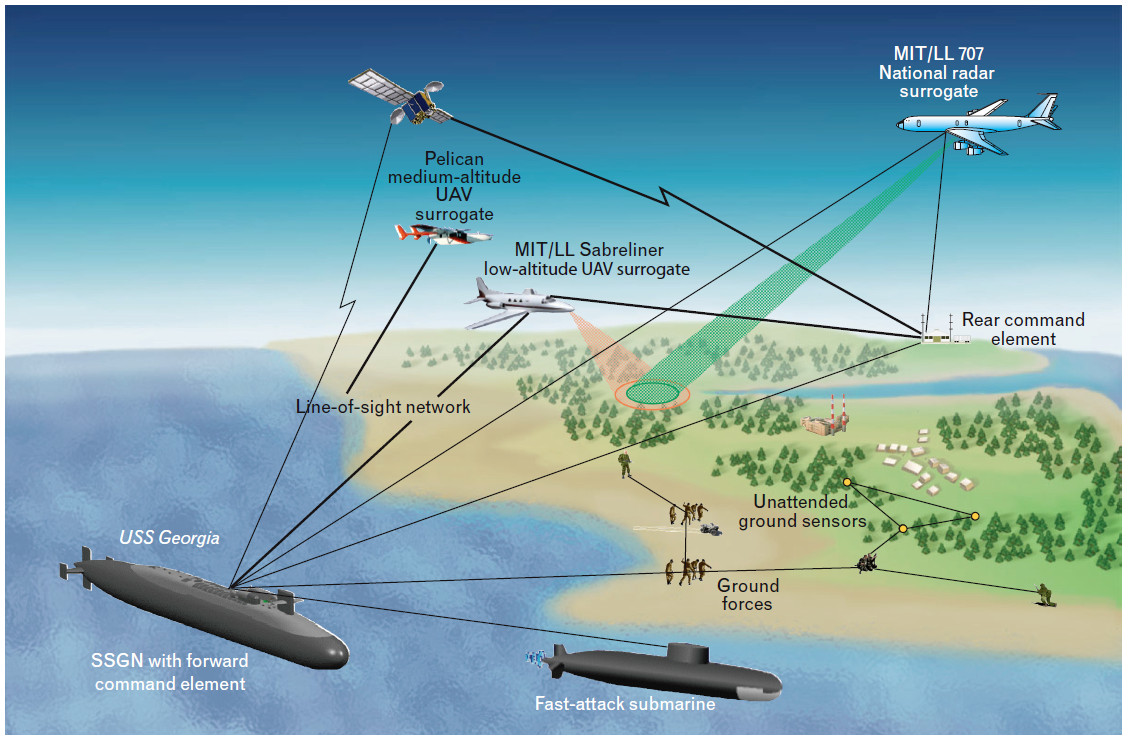
In the air, these included the Pelican, a highly modified, pilot-optional Cessna 337 propeller-driven aircraft, and a specially configured Sabreliner twin-engine business jet. The Pelican belonged to the U.S. Naval Postgraduate School’s Center for Interdisciplinary Remotely-Piloted Aircraft Studies (CIRPAS) and was configured at the time in a way that matched the capabilities of the MQ-1 Predator drone. The Massachusetts Institute of Technology’s (MIT) Lincoln Laboratory operated the Sabreliner as a surrogate for smaller, lower-altitude unmanned aircraft.
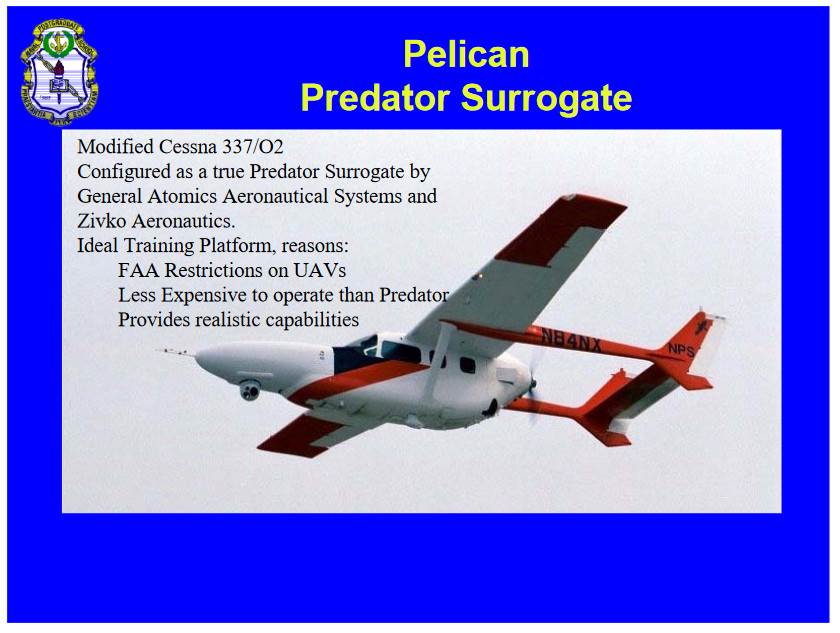
The Lincoln Lab also had their heavily modified Boeing 707 airliner, nicknamed Hannah, a well-known cutting-edge communications and sensor testbed, in the air playing the role of a airborne radar with synthetic aperture and ground-moving-target indicator capabilities. This effectively made it, in part, a surrogate for a U.S. Air Force E-8C Joint Surveillance Target Attack Radar System (JSTARS) battlefield management command and control aircraft.
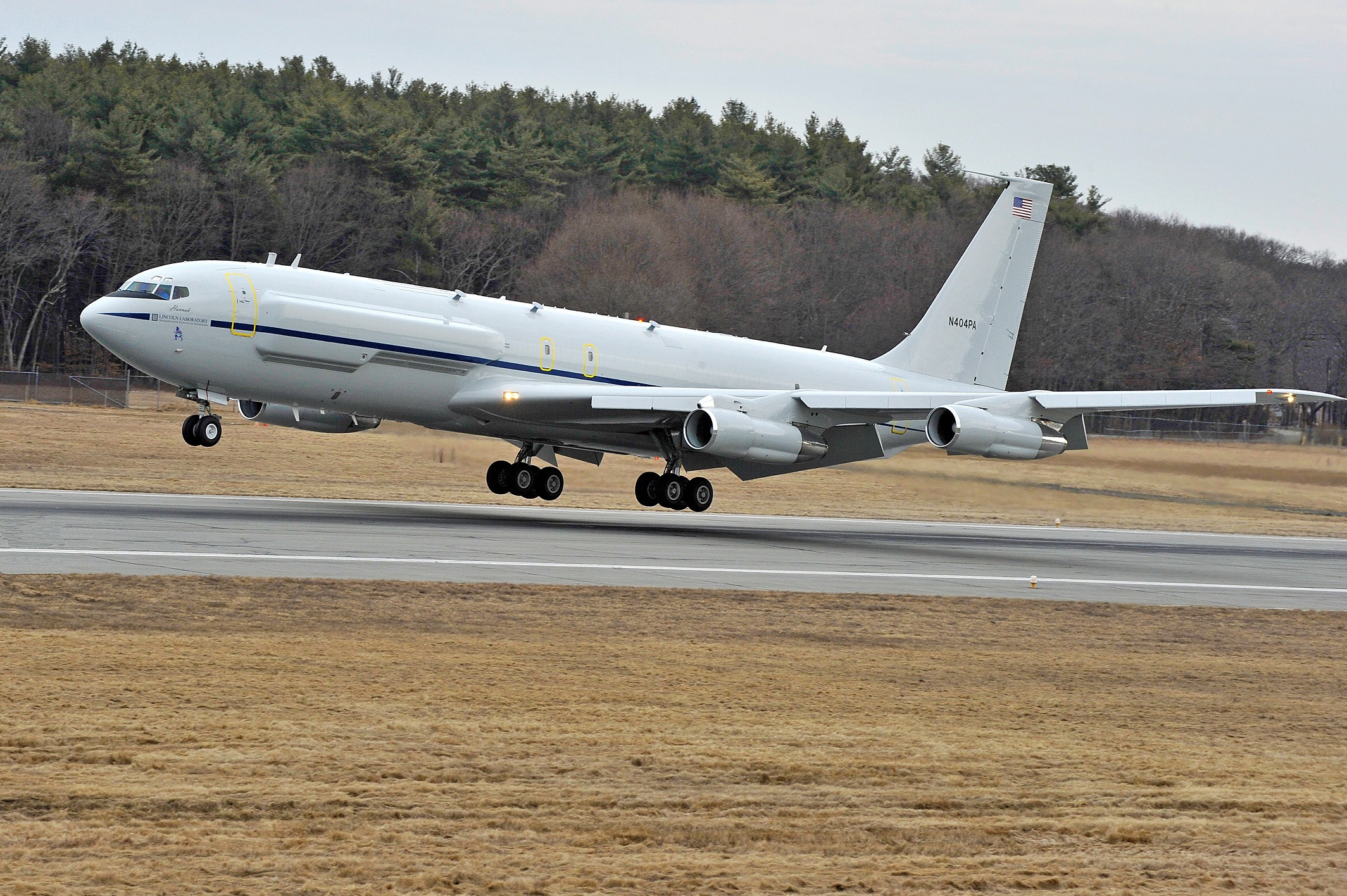
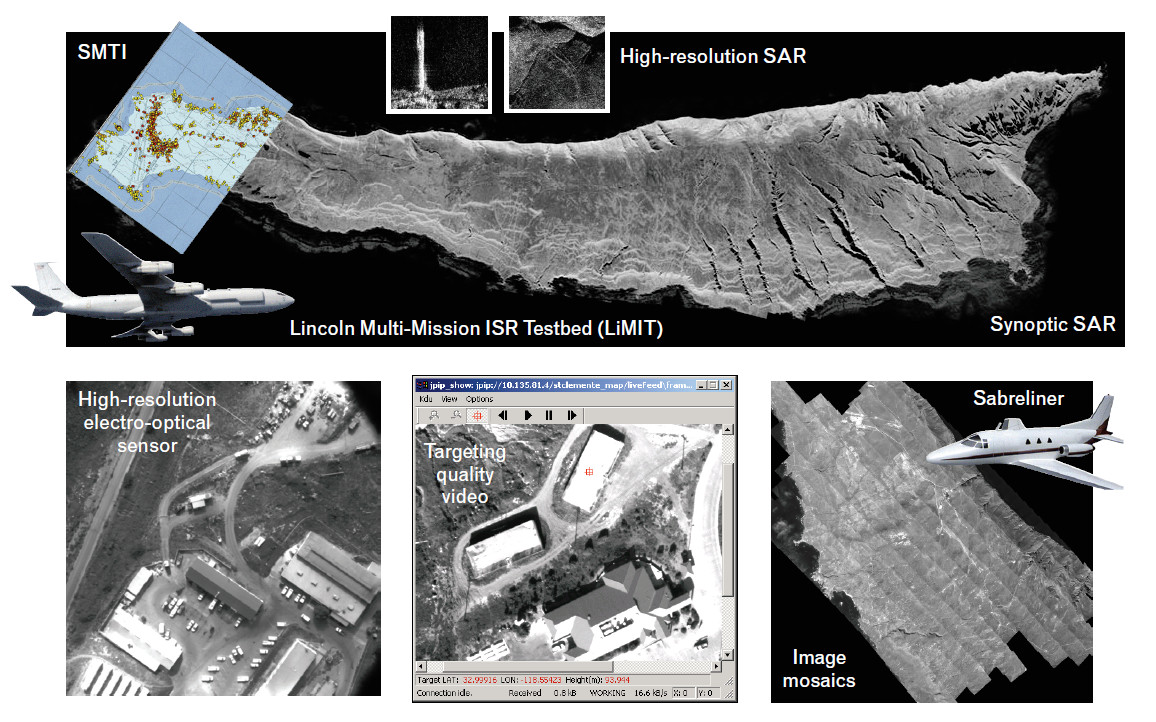
Navy EA-6B Prowler electronic warfare planes and EP-3E Aries II intelligence, surveillance, and reconnaissance aircraft also took part in Trident Warrior and fed information into this network of information sources.
Down below, Georgia was networked together with other vessels taking part in Trident Warrior, including two Los Angeles class fast attack submarines, the USS La Jolla and USS Pittsburgh. In addition, members of the Silent Hammer experiment team were on board the first in class amphibious assault ship USS Tarawa and the Wasp class USS Bonhomme Richard, which were also taking part in the larger exercise.
Ashore, U.S. Navy SEALs, along with other unspecified attached special operators, likely including U.S. Air Force Joint Tactical Air Controllers (JTAC), were in direct contact with Georgia. They emplaced their own “unattended” sensors to monitor for potential hostile activity and otherwise fed even more data back to the submarine.
We also know that the Defense Advanced Research Projects Agency (DARPA) supplied unspecified payloads, as well as sensor systems for the exercise. Georgia itself demonstrated how she might launch unmanned aircraft and an unmanned underwater vehicles (UUV) during the exercise to support intelligence collection efforts. We will talk more about these shadowy developments later on.
Data fusion pioneers
The amount of intelligence information collected during the exercise was staggering. The supporting aircraft, ground sensors, and other offboard sensors collected more than 21,000 individual images during the exercise. In total, the task force created nearly 11 gigabytes of data, including thousands of textual alerts and nearly 3,000 actual intelligence “products,” such as PowerPoint presentations distilling various pieces of information, according to an article in a 2007 edition of the Lincoln Laboratory Journal.
Unfortunately, this wealth of information also risked being overwhelming. So, the Navy and the Lincoln Lab had also developed a computerized and heavily automated network system, state-of-the-art for the time, that allowed the command center onboard Georgia to rapidly parse through the mountains of available information for the most relevant data and only download what they needed in full. Being able to avoid downloading unnecessary information was particularly important given the bandwidth limitations in the data links available between the submarine and its various offboard information sources, especially 15 years ago.
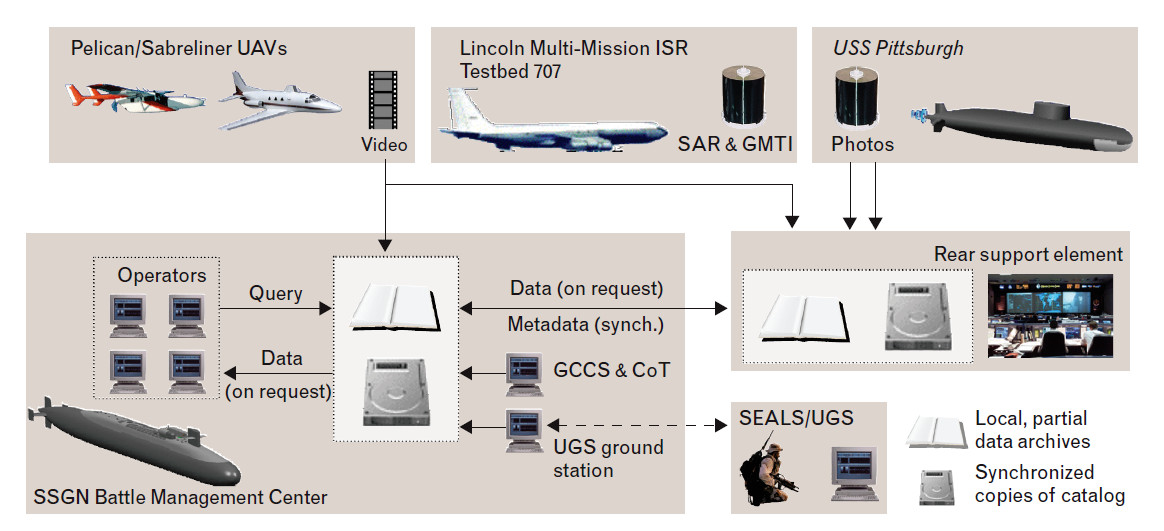
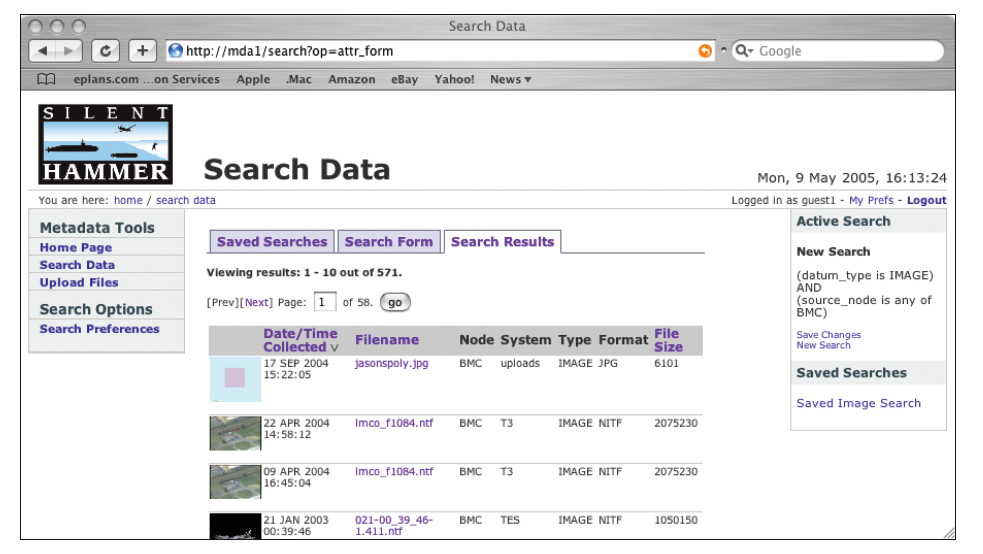
Silent Hammer planners, as well as the Lincoln Lab, had been acutely aware of data sharing issues based on lessons learned from a smaller SSGN developmental experiment in 2003, nicknamed Giant Shadow, which involved the USS Florida and took place in and around the secretive Atlantic Undersea Test and Evaluation Center, or AUTEC, off the coast of Andros Island in the Bahamas. Similar to the Silent Hammer scenario, Giant Shadow centered on an operation to destroy a chemical weapons plant that mock terrorists were operating on shore.
“We can get this [imagery] real-time down to the submarine,” U.S. Navy Captain William Toti, then commander of the Florida, said in an interview at the time with “60 Minutes” on CBS News. “The SEALs can look at it real-time as they’re planning their missions, and have a better sense of what’s going on.”
The problem in that exercise, as it turned out, had been that there quickly became too much information for personnel on the submarine to sift through and process in real-time. “The providers, not the consumers, decided what information to transmit and when, which created a situation whereby analysts were overloaded with processing extraneous information, yet still had insufficient information for decision support,” according to the 2017 Lincoln Laboratory Journal article.
The flow of information during Silent Hammer was better, but still showed room for improvement. The vast quantities of data meant that it was still easy for intelligence officers to miss important new developments as they did their best to prioritize the efforts. Of the more than 21,000 images that various platforms collected during the exercise, less than 7,000 made their way into the networked database and “blue team” personnel only ever looked at 361 of them at any resolution, downloading just 45 of them in full for more extensive analysis. Still, the task force that Georgia led was ultimately able to find all of the simulated threats and successfully carry out the mock strikes to neutralize them.
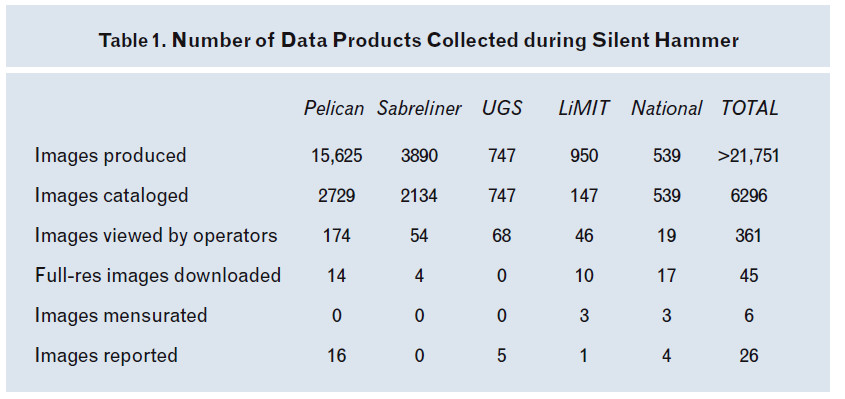
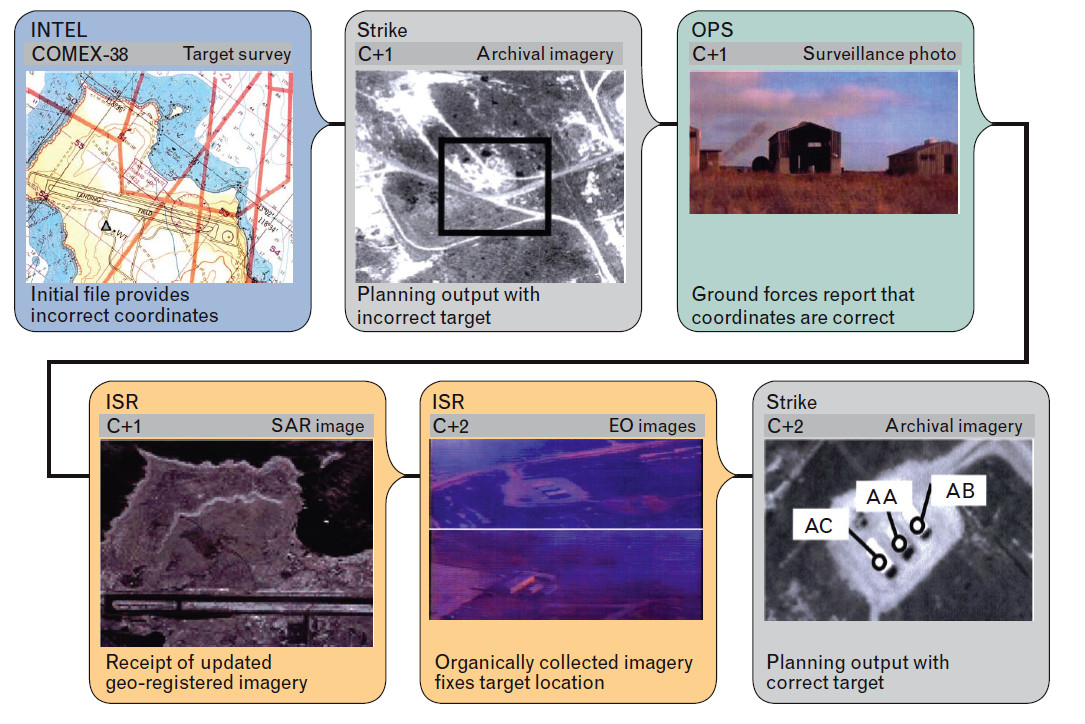
Secretive payloads
For how much is known about Georgia’s participation in Silent Hammer, as well as the overall scope and scale of the intelligence gathering and networking systems employed during the exercise, there is little information about the testing of the submarine’s capabilities to launch underwater unmanned vehicles (UUVs) and unmanned aircraft.
It’s not clear what type or types of UUVs participated in Silent Hammer, or if Georgia deployed any of them herself. However, during the earlier Giant Shadow exercise, Florida had become the first Navy submarine to launch and recover the Seahorse Autonomous Undersea Vehicle (AUV) via a modified missile tube. It is very possible that this undersea drone took part in Silent Hammer, as well.
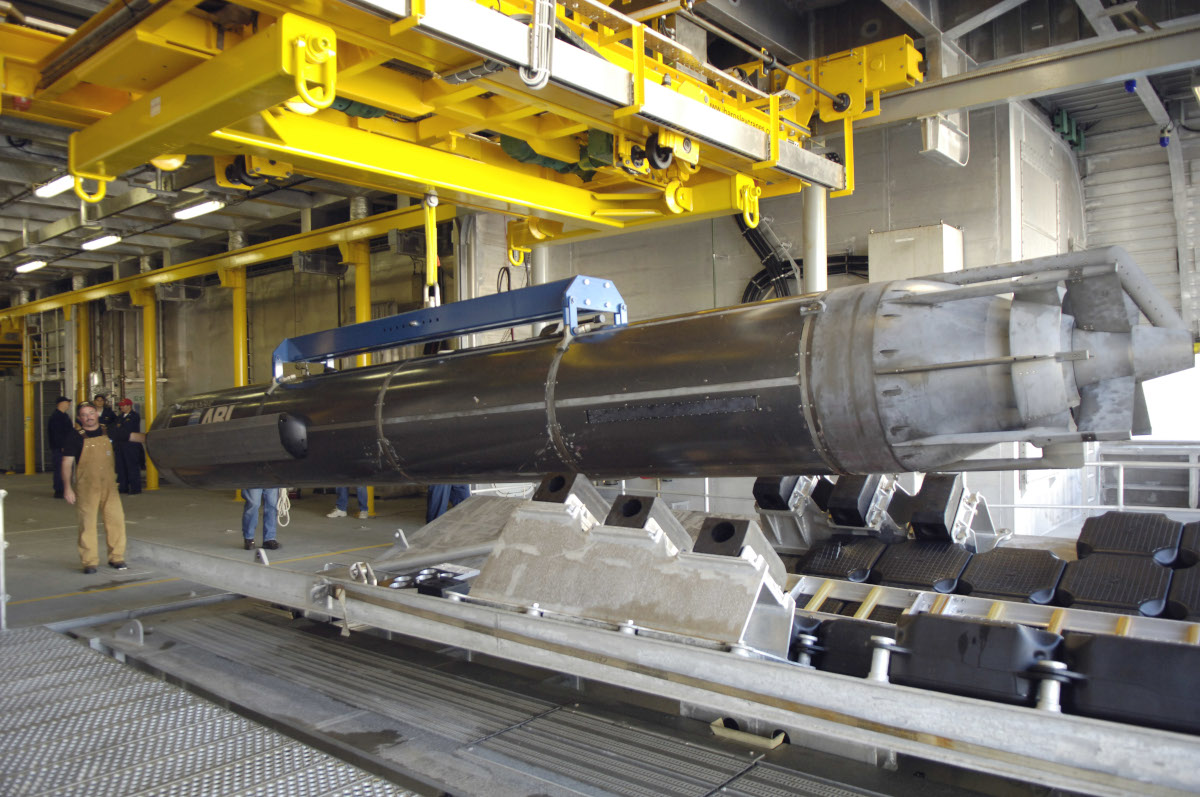
The Applied Research Laboratory (ARL) at the Pennsylvania State University had begun development of Seahorse in 1999 under contract to the Naval Oceanographic Office, or NAVOCEANO. At 28 and a half feet long and weighing 10,800 pounds, this underwater drone was more than 10 feet longer than a Mk 48 heavyweight torpedo and just over 7,100 pounds heavier.
Its main job was undersea mapping using a variety of sensors, including multi-beam bathymetric and synthetic aperture sonars, an Acoustic Doppler Current Profiler (ADCP) and a Conductivity, Temperature and Depth (CTD) sensor. Those same sensors could be used to scout out mines and other potential underwater hazards and, in the decades since the Navy took delivery of Seahorse, the service has acquired and fielded a large number of increasingly more capable torpedo-shaped UUVs of various sizes for mapping and mine clearance missions, among others.
The Flexible Payload Module
Georgia didn’t actually launch any unmanned aircraft during Silent Hammer, according to the Navy, but did release two Stealthy Affordable Capsule System (SACS) canisters, each containing an “inert test shape simulating a UAV,” from a Flexible Payload Module (FPM) installed in one of the submarine’s missile tubes.
Since the 1990s, the Navy had been very interested in the idea of pairing unmanned aircraft with submarines to expand the ability of the boats to scout ahead and collect intelligence. Drones working with subs could also act as communications and data relays, probe and collect information on enemy defenses, and potentially even strike targets themselves. For example, in March 1996, the Los Angeles class attack submarine USS Chicago took part in a demonstration in which it tested its ability to both communicate with and actively control an early example of what was then known as the RQ-1 Predator.
Development of the FPM dates back to at least 2000, when the Navy tasked two separate industry consortiums with crafting concepts for future submarines designs, as well as payloads and sensors for them, with an eye toward technologies that could be operational in the years to come. The Navy and DARPA managed this project, aptly named Submarine Payloads and Sensors, cooperatively.
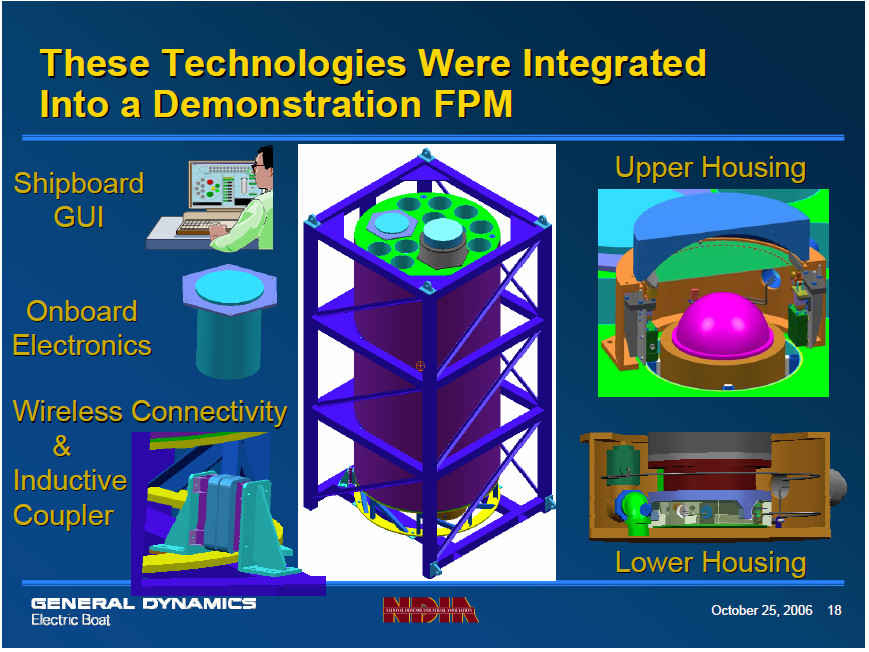
Northrop Grumman, a member of Team 2020, one of the consortiums, which Lockheed Martin headed up, developed the FPM. General Dynamics Electric Boat, the United States’ premier submarine builder, which had built the Ohios, among others, and was involved in the development of the Virginia class attack submarine at the time, was also part of Team 2020.
The FPM was effectively an insert that would slot into a large diameter ballistic missile tube on a submarine, but could be adapted to hold multiple payloads, including numerous unmanned aircraft, that the crew could then launch independently. General Dynamics Electric Boat described it as a “plug and fight” system.
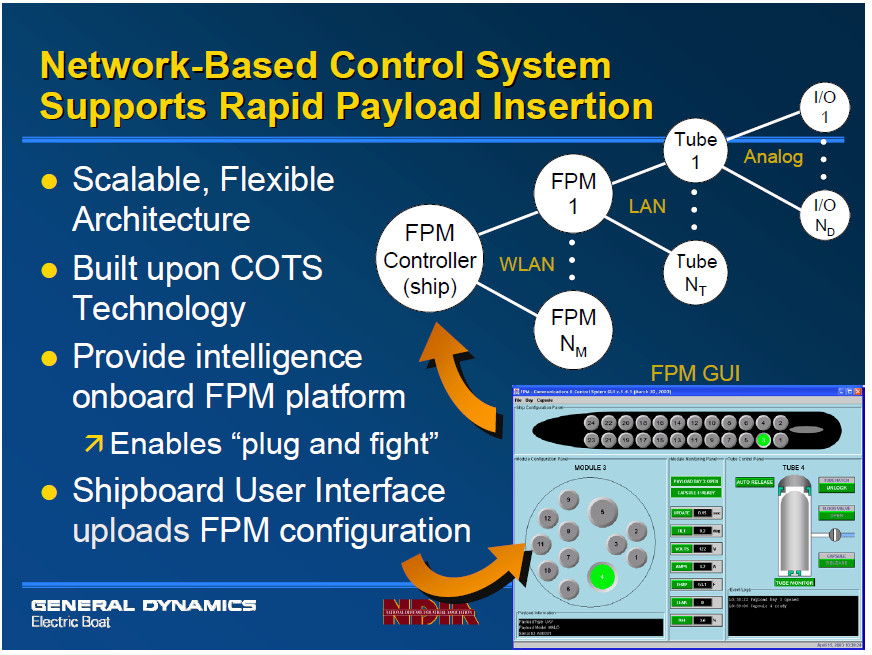
Northrop Grumman designed the first iteration, which had 10 14-inch tubes and a pair of larger 20-inch ones, specifically around the dimensions of the Ohio’s missile tubes. The second FPM prototype, which Georgia carried during Silent Hammer, had only three tubes of an unknown diameter. Each one of those could accommodate a payload inside a SACS, another Northrop Grumman development.
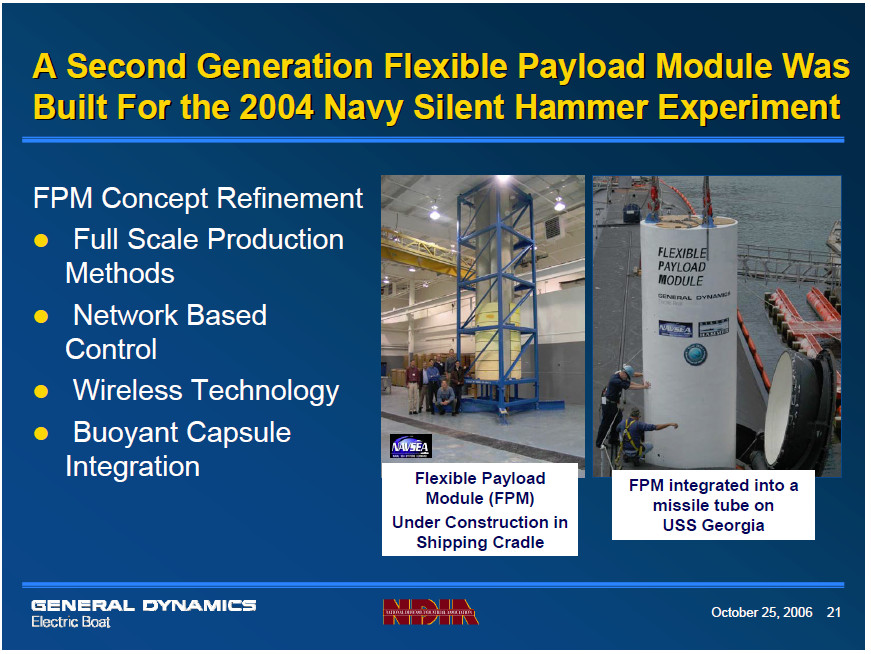
“The FPM and SACS comprise an encapsulation system that facilitates the launch of non-marinized payloads and weapons from a submarine,” according to the article on Silent Hammer from the Winter 2005 issue of Undersea Warfare. “This allows the use of Navy air- or surface-launched payloads – plus those from other services – without the need to redesign them for launching in an undersea environment.”
SACS was “adaptable for long-term storage, variable release depths, launching under broaching or surface-loitering conditions, and the ability to encapsulate small or large payloads,” according that same article.
“In the case of the SUAV [submarine-launched unmanned air vehicle], SACS rises buoyantly to the surface, a sensor in the capsule detects broach, the SACS end-cap is blown away, and the SUAV booster ignites to clear the water and build vertical speed,” notes from a presentation that Steve Weinstein and William McGannon gave at the National Defense Industry Association’s (NDIA) 2002 Joint Undersea Warfare Technology Spring Conference explains. “At the proper moment, the SUAV wings are extended from alongside its long slender body to the horizontal position, the flight control software tilts the SUAV over to the horizontal flight position and once in stable flight, the SUAV turns and climbs to the pre-planned altitude to begin its mission.”
At the time, Weinstein and McGannon were employed with the Naval Sea Systems Command’s (NAVSEA) Submarine Sensor Systems division.
The other industry collective that had taken part in the Submarine Payloads and Sensors program, called Forward Payloads And Sensors for Submarines (Forward PASS), had developed a similar system, known as the Broaching Universal Buoyant Launcher (BUBL), that worked in much the same manner. However, BUBL’s design was meant to work with a variety of existing launcher options on submarines, including torpedo tubes and countermeasures launchers, or even be carried externally. Of course, the external carriage option could have created performance problems or increased the sub’s acoustic signature, making it more vulnerable.

Raytheon was the team leader for Forward PASS, which also included Boeing and Pennsylvania State’s Applied Research Laboratory, among others. General Dynamics Electric Boat was part of both teams in order to provide its extensive knowledge base to help with submarine development and integration questions. There is no mention of Georgia employing BUBL during Silent Hammer.
Submarine-launched drones
While we don’t know what drones Georgia was supposed to have been simulating the launch of from the FPM specifically, Northrop Grumman had also already developed at least one submarine-launched drone known as Sea Ferret in the 1990s. This was an evolution of Ferret, which the company had originally developed for the U.S. Army.
The Sundstrand TJ50 turbojet-powered Ferrets and Sea Ferrets are what we would call loitering munitions today. The approximately 145-pound drones carried both electro-optical sensor packages and 20-pound warheads and could fly out to a maximum range of around 370 nautical miles and a top speed of 300 knots and still be able to orbit around a target area for around two hours.
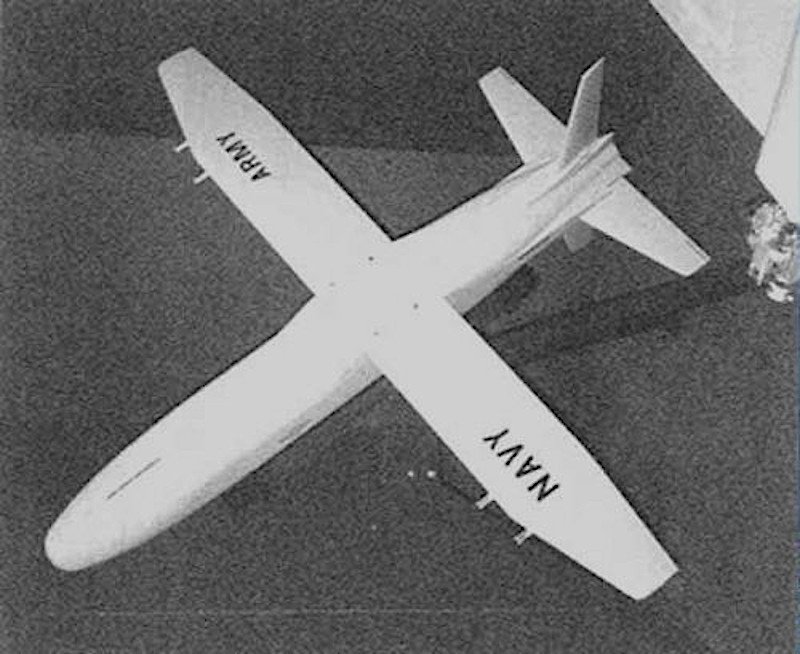
In December 1996, the USS Asheville, another Los Angeles class attack submarine, simulated launching the Sea Ferret during a technology demonstration. A Cessna 206 light aircraft carried one of the drones under its wing to then simulate the unmanned aircraft in flight. Northrop Grumman had intended the final system, which the Navy did not ultimately adopt, to be torpedo tube-launched using a modified canister for a UGM-84 submarine-launched Harpoon anti-ship cruise missile.
Still, the 1996 test “successfully simulated organic and inorganic UAV operations & SOF support,” according to Weinstein and McGannon 2002 NDIA presentation. It is certainly possible that Northrop Grumman could have developed a follow-on of some sort to Sea Ferret at the time of Silent Hammer.
We also know that the Navy had been holding workshops and other defense industry engagement events to gauge options for submarine-launched unmanned aircraft starting in 2000, around the same time as the Submarine Payloads and Sensors initiative. A slide from a General Dynamics Electric Boat briefing at the 2006 NDIA Systems Engineer Conference, which also touches on the Flexible Payload Module (FPM) development, shows concept art for at least five different potential submarine-launched drone designs.
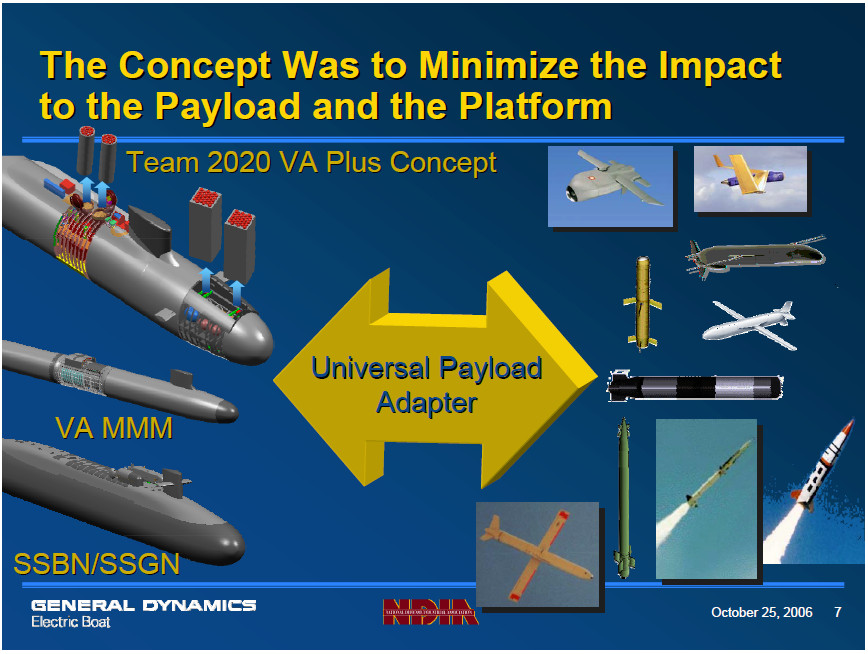
By 2002, a team that included General Dynamics, Lockheed Martin, AeroVironment, and Kollmorgen, had also demonstrated a modified Universal Modular Mast that could shoot small unmanned aircraft into the sky from periscope depth. An artist’s conception of the system shows a drone design virtually identical to the Blackwing, which AeroVironment officially began developing four years later for the Navy as a submarine-launched system.
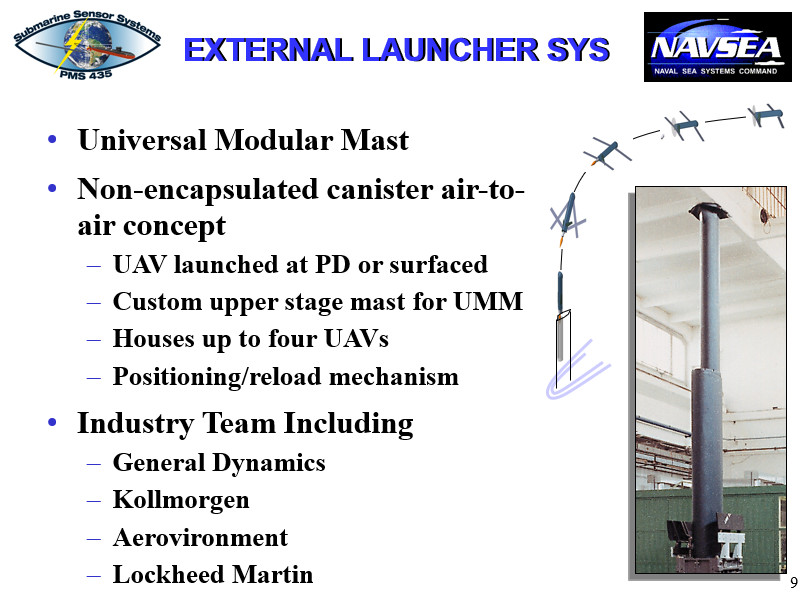
In his guidance for 2005, then Chief of Naval Operations Admiral Vern Clark had also called for a follow-on Silent Hammer II exercise that “should employ aerial sensors (UAVs) in addition to ground sensors and exercise full range connectivity links.” It’s not clear if Clark had wanted to demonstrate a true submarine-launched drone capability or if that exercise ever ultimately occurred.
Lockheed Martin’s mysterious Cormorant
Of all the submarine-launched unmanned aircraft in development around the time of Silent Hammer, by far, the most interesting was Lockheed Martin’s shadowy Cormorant, a product of the company’s Skunk Works advanced design division. DARPA managed this program, also known as the Multi-Purpose Unmanned Aerial Vehicle (MPUAV), which sought to develop a relatively large, stealthy, jet-powered drone that a submarine could both launch and recover.
Patent documents show that Cormorant was in development at least as early as 2004. A subsequent official Lockheed Martin video presentation on the Cormorant makes clear that, while DAPRA was officially in charge of the project, it was informed, at least in part, by Navy requirements relating to the Ohio SSGNs.
“The Navy came to us for our concepts for a wide range of unmanned aircraft that could operate from aircraft carriers or surface ships or even submarines,” Bob Ruszkowski, then-Lockheed Martin’s MPUAV Team Project Manager and Technical Lead, said in the video. “This idea was unique in that it was the first time someone had thought about the idea of launching and recovering the vehicle while the submarine was still submerged.”

The Cormorant, in concept, would be launched from a modified missile tube on an Ohio class SSGN at a depth of up to 150 feet and then float the surface “like a cork,” according to Ruszkowski. Rocket boosters would then propel the four-ton, titanium-skinned craft into the air, a traditional turbofan jet engine would take over. During launch, as well as recovery, the intakes and exhausts for the engine would be sealed off from the water.
“The aircraft uses its stealth and mission planning to penetrate hostile airspace,” Ruszkowski continued. “Once it’s in there, it can do a variety of missions, that could be collecting intelligence and reconnaissance on weapons of mass destruction sites, it could be supporting special operations forces. But whatever it’s doing, it’s using its stealth and its mission planning to avoid detection.”
One patent that Lockheed Martin filed in 2004 regarding Cormorant included artwork depicting the drone releasing weapons, suggesting that Lockheed Martin, DARPA, and the Navy may have been considering a strike role from the drone, as well. A Lockheed Martin briefing from 2005 describes the unmanned aircraft as being capable of carrying a 1,000-pound payload in a modular bay, which could include sensors, communications relay systems, and even supplies that it could drop to personnel at a designated drop zone.
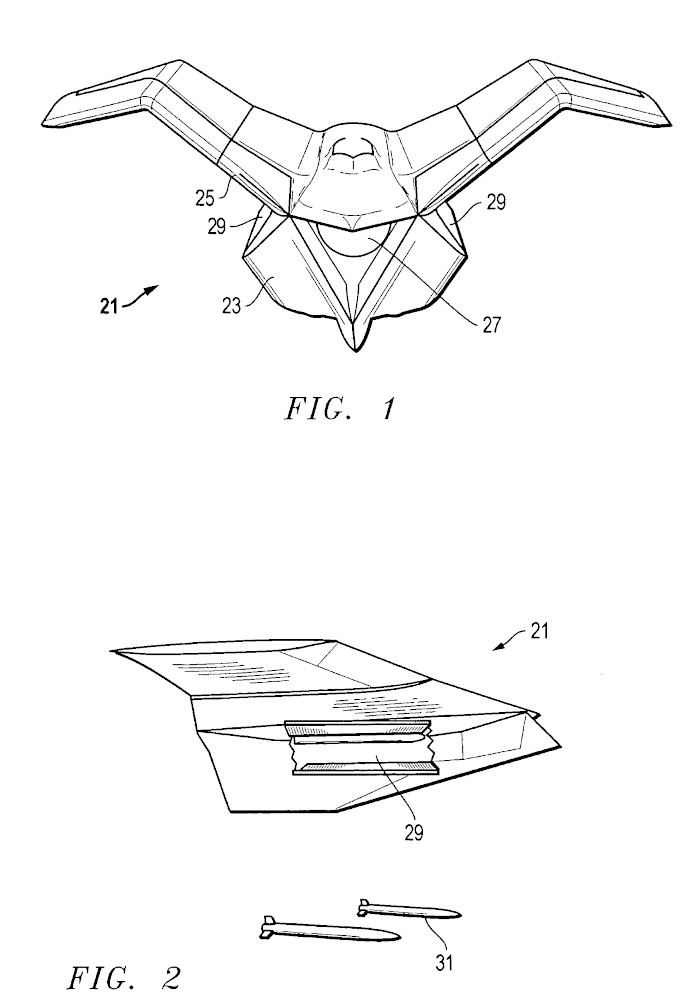
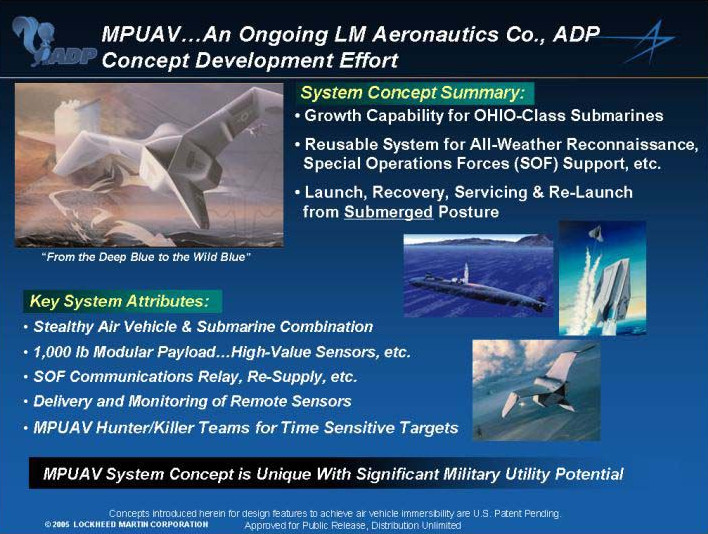
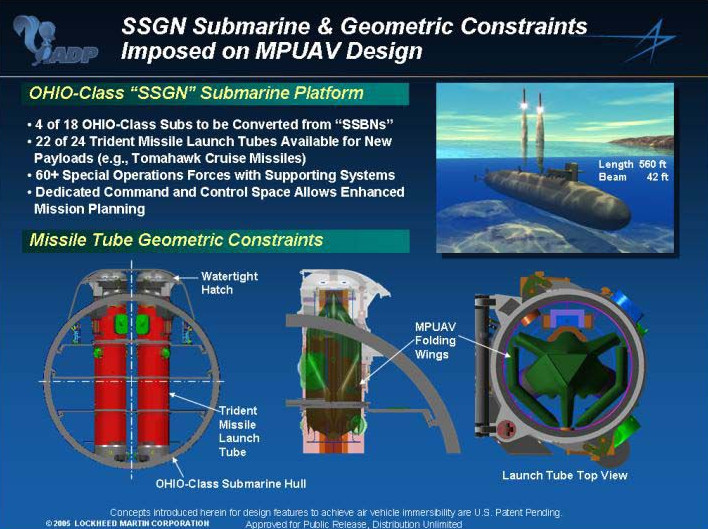
After completing its mission, it would return to a rendezvous point and deploy a parachute, landing safely in the water. The submarine would then send out its own tethered remotely operated vehicle to attach a cable to the drone and reel it back in.
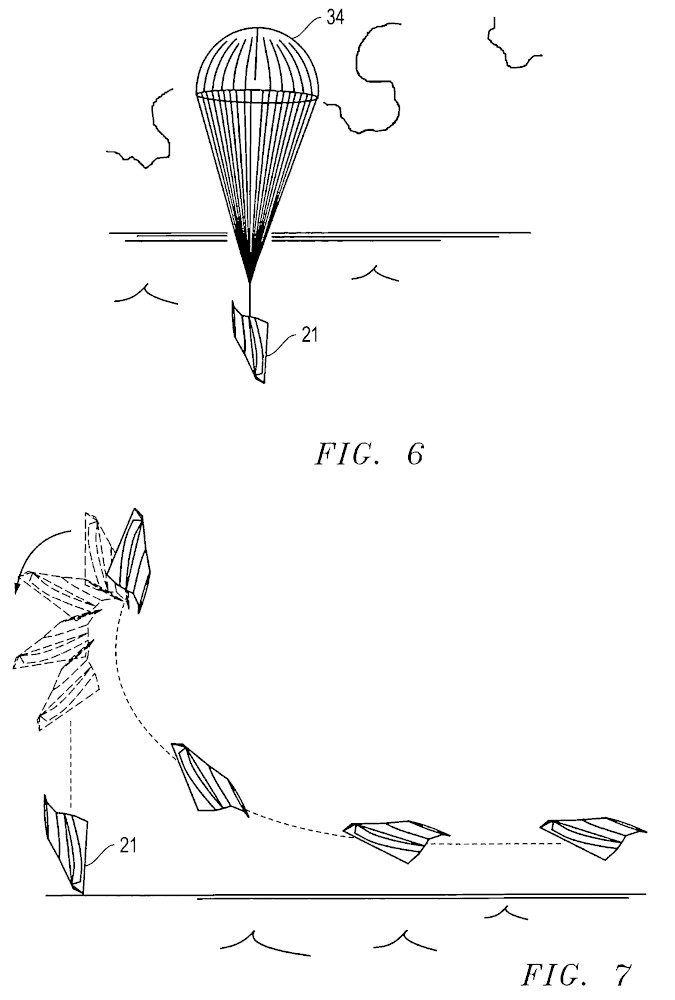
It’s unclear how far the program progressed, but we do know that Lockheed Martin conducted a number of disclosed tests, including releasing a test article from a simulated launch tube underwater, dropping that test article into the water, and evaluating the recovery concept that Ruszkowski had described in the video.
Theoretically, Cormorant could have worked using a launcher mounted on a surface ship, as well. The 2004 patent shows an artist’s conception of a surface ship releasing a Cormorant off the side.
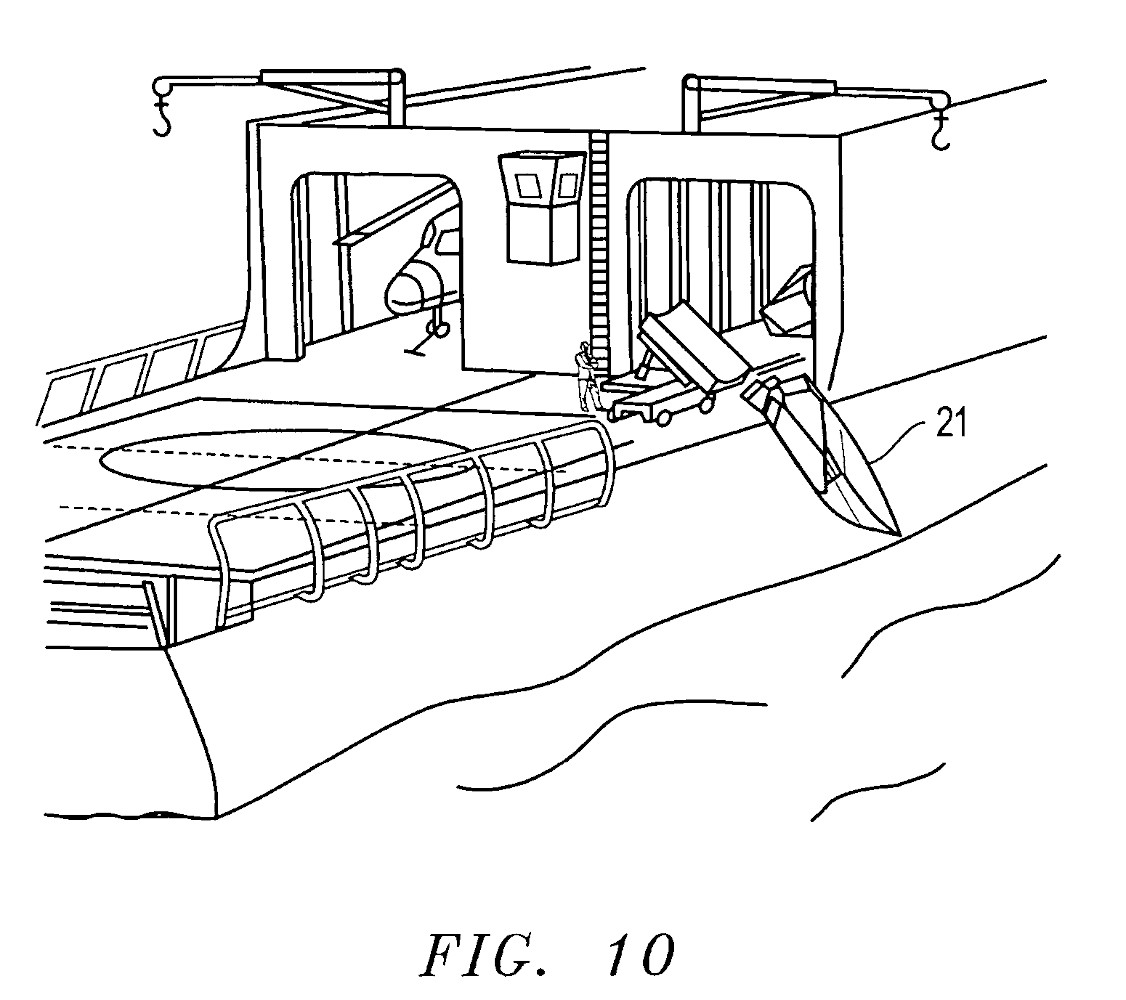
Publicly, DARPA canceled development of Cormorant, ostensibly due to budget cuts, in 2008. It’s not clear whether development of the system continued on afterward, possibly in the classified realm, under a different program. Discussions about the unmanned aircraft, or its underlying concepts, virtually evaporated, even from Skunk Works, which had been promoting the project heavily up until then.
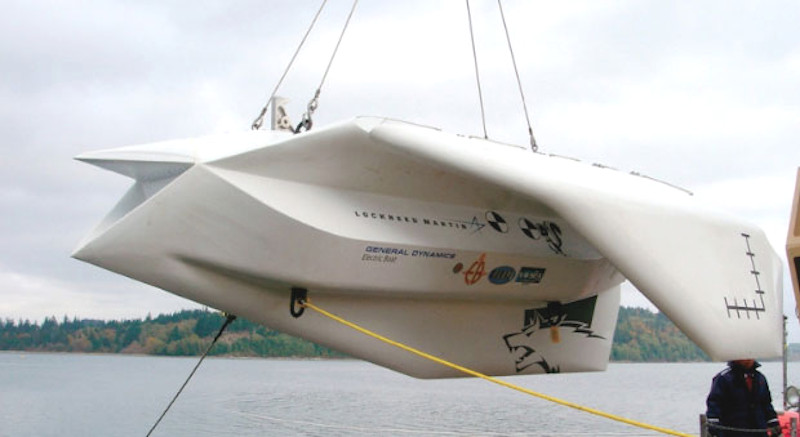
In 2009, Lockheed Martin did
file another patent relating to an unmanned aircraft that could be launched and recovered in the water. This application described a system that used an electric ducted fan both for self-propelled operation in the water, as well as in the air. The concept art curious shows an aircraft shaped like an early Cold War Soviet MiG-15, which was reportedly because Lockheed Martin had utilized a modified radio-controlled model of one of these aircraft to test the electric fan propulsion system.
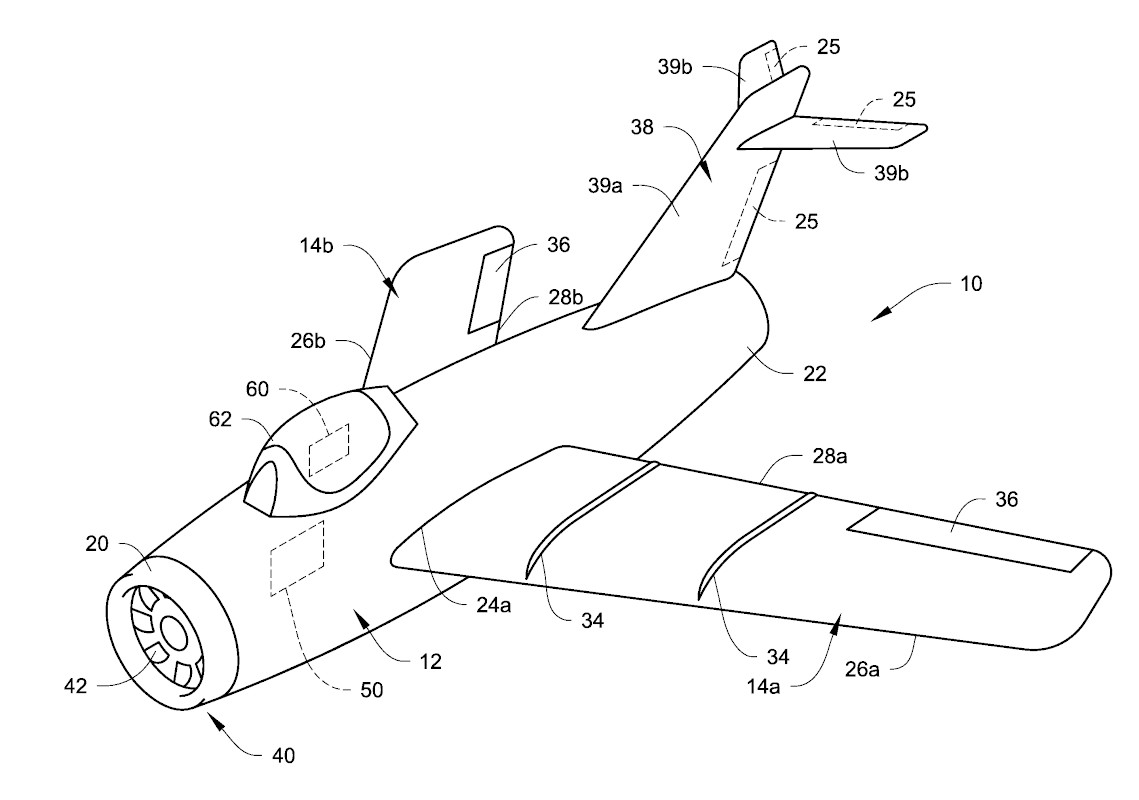
The Ohio class SSGNs enter service
For as open as the Navy was in the early 2000s about the book it was writing on how to employ the Ohio SSGNs, and what capabilities they might have as a result of their refits and in the future, since they actually entered service toward the end of that decade there has been relatively little information about how they have been putting that doctrine into action. Ohio was the first to rejoin the fleet, with General Dynamics Electric Boat delivering the converted submarine on Dec. 17, 2005. A ceremony to mark its return to service occurred nearly two months later.
Florida and Michigan followed on Apr. 8 and Nov. 22, 2006, respectively. For unclear reasons, Michigan did not have her official return to service ceremony until June 2007. Georgia was the last to arrive on Dec. 18, 2007.
The bulk of the official news reporting about these four boats has been primarily concerned with deployments, returns to home port, port visits, and general announcements about their participation in exercises. “The missions that we do are very exciting and challenging,” U.S. Navy Captain Murray Gero, then the commanding officer of the Ohio’s Blue crew, said in one typical pre-deployment story in 2009.
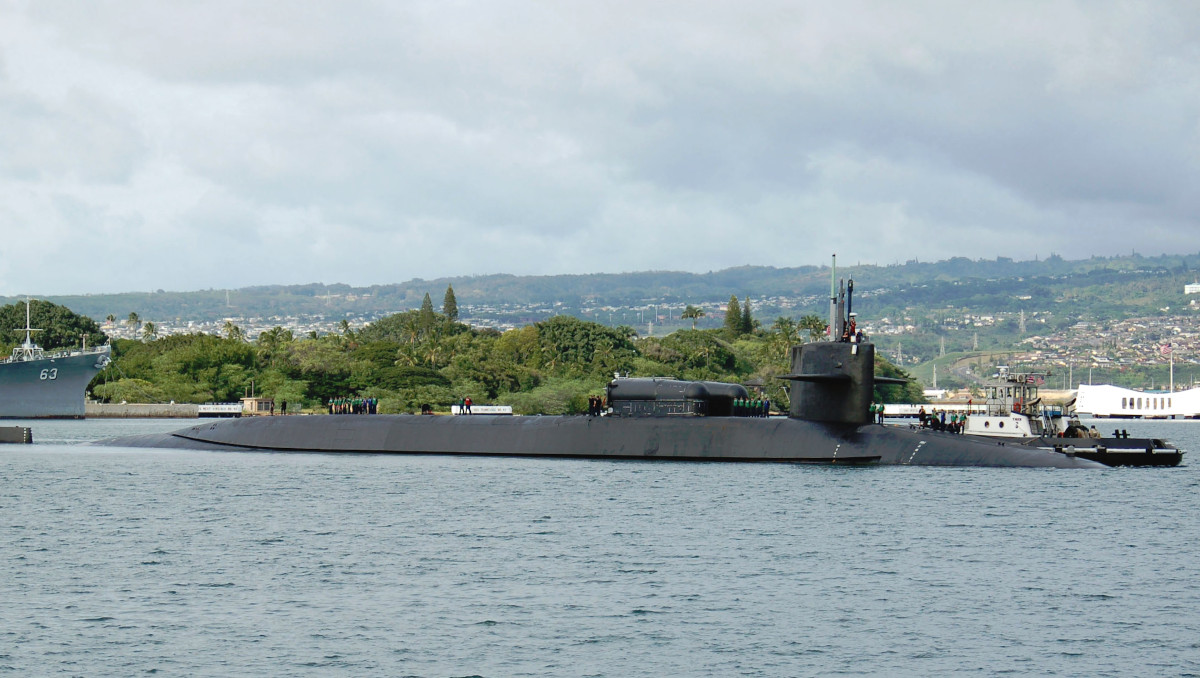
“We typically go to sea with over 100 tomahawk missiles, and that basically replaces a tomahawk missile inventory of three surface warships,” he continued, focusing on the time-sensitive strike mission. “This increases the flexibility of the surface fleet, because we basically allow them to reassign those three ships as soon as we get into our operating theater.”
The Captain did add that the boat was capable of other missions, including intelligence gathering and special operations support, and that “they are very complex, and they involve very close coordination with several outside agencies, including SEALS.” He didn’t offer any more specific details, though.

Conventional deterrence and actual combat
We do know that the boats have flexed their strike muscles both for deterrent purposes and during actual operations. In 2010, Florida, Michigan, and Ohio nearly simultaneously made port visits at Diego Garcia in the India Ocean, in Busan in South Korea, and in Subic Bay in the Philippines, respectively, in what some observers took to be a show of force aimed at China.
“This demonstrated that these platforms offer signaling capabilities that other conventional missile systems lack,” Forrest E. Morgan, a political scientist at the RAND Corporation think tank wrote about these events in a study in 2013. “Yet, one might doubt whether U.S. leaders would even allow SSGNs to surface while on patrol in an engagement zone during a crisis when doing so might put them at risk of attack.”
In 2011, Florida also notably took part in the open stages of Operation Odyssey Dawn, the NATO-led intervention into Libya that led to the ouster and death of long-time leader Muammar Gaddafi. The submarine fired 93 Tomahawks over the course of the operation, 90 of which hit their targets.

“By virtue of their concealment and endurance, the SSGN platform forces our adversaries to consider that they could be operating almost anywhere at any time,” then-Vice Admiral John Richardson, Commander of Naval Submarine Forces at the time, said upon Florida’s return to its homeport at Naval Submarine Base Kings Bay in Georgia on Apr. 29, 2011. “The sensor suite on the boat allows the captain to gather information and intelligence in situ, passing that back to the commander and responding on the spot. When you combine all that with the tremendous combat capability the boat brings – land attack missiles, special forces, torpedoes – that’s a lot of bets the enemy has to cover down on.”
Richardson subsequently became Director of Naval Nuclear Propulsion and then Chief of Naval Operations, the service’s top uniformed officer. He retired in August 2019.
In 2017, Michigan had appeared again in Busan at a time of heightened tensions with North Korea, which was also seen as a signal to the regime in Pyongyang. U.S. President Trump had also revealed and highlighted the submarine’s presence in the region as a counter to North Korean aggression in a telephone conversion with his counterpart in the Philippines, Rodrigo Duterte, which subsequently leaked out into the press. Michigan did go on to conduct exercises with the Nimitz class aircraft carrier USS Carl Vinson and her associated Carrier Strike Group, which had also deployed the region.
Earlier in November 2019, ABC News‘ “Nightline” aired a segment in which David Muir got to spend a day aboard Florida, which is presently operating in the Mediterranean Sea on what was described as a “classified mission.” Muirs interviews with U.S. Navy Rear Admiral William Houston and Captain Seth Burton offered some additional insights into the SSGN operations. Houston is presently tripled-hatted as Director of Plans and Operations for U.S. Naval Forces Europe/U.S. Sixth Fleet, the Deputy Commander of Sixth Fleet, and the Commander of Submarine Group Eight. Burton is the current commander of the Florida.
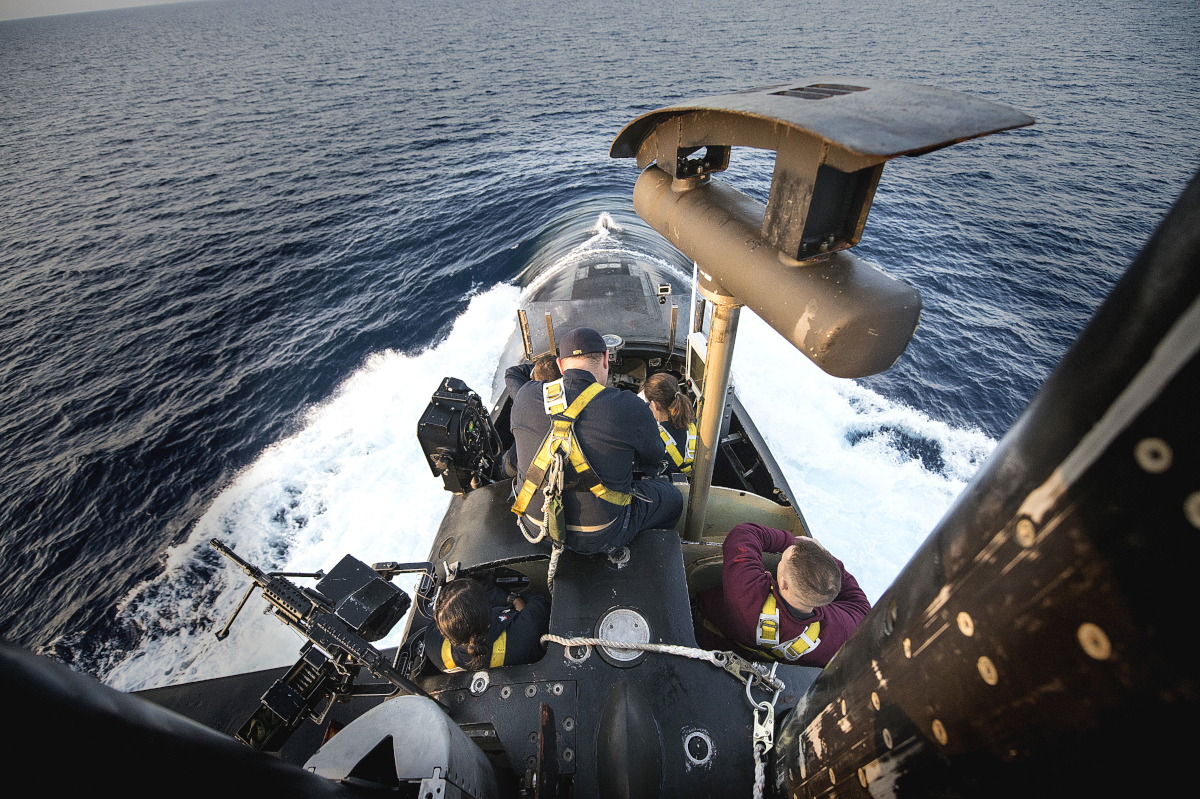
“We’ve put this submarine right in this area of the eastern portion of the Mediterranean to counterbalance the Russian buildup in Syria,” Houston told Muir. “We’re watching them [the Russians] very very closely. There’s really not a day where we’re not watching them, every single day.”
“If you just look at the region and you’ve got ISIS in Northern Africa, you’ve got what’s going on on the Turkey Syria border right now, the fact that you’re here in the Mediterranean, does that give you a set of silent eyes for the U.S.?” Muir asked Burton. “Absolutely. It gives them eyes where no one knows that they’re being looked at,” he replied.
We also know that the Ohio SSGNs regularly conduct intelligence gathering missions during their patrols and work together with SEAL teams and other special operations forces on a routine basis around the world. As Captain Murray Gero noted back in 2009, these boats offer their crews unique experiences and they are among the hottest boats to get on in the fleet.
New capabilities?
If operational information about the Ohio class SSGNs is limited, then details about upgrades and new technologies for these boats have been even scarcer. This stands in stark contrast to how open the Navy had been about the capabilities of these converted submarines early on and how willing it had been to discuss what it might have in store for them in the future, including the drones and UUVs, both of which have seen quantum leaps in the expansion of their capabilities over the last decade and a half.
We do know that by the late 2000s, the Navy was integrating a signals intelligence collection system, called Radiant Gemstone, onto at least some Los Angeles class attack submarines, which you can read about more in this past War Zone piece. This came along with the necessary data links and software backend, known as Radiant Mercury, to rapidly exchange that information with the National Security Agency.
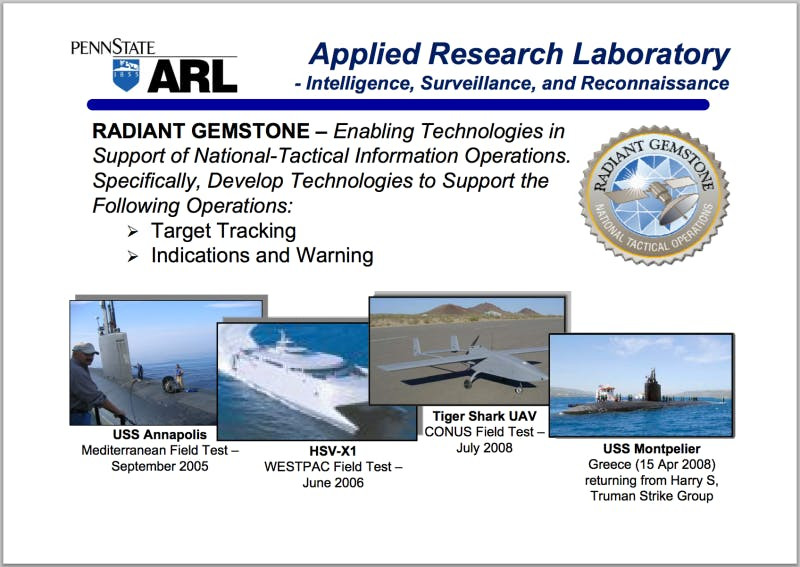
“The RADMERC [Radiant Mercury] program facilitates sharing of critical information across security domains and among allied, coalition and inter-agency partners,” an official list of the Navy’s Space and Naval Warfare Systems Command’s (SPAWAR) programs as of 2017 explained. “The Radiant Mercury product provides cross-domain information sharing capabilities from Top Secret/Sensitive Compartmented Information (TS/SCI) to General Service (GENSER) and GENSER to Unclassified.”
This sounds very much like an evolution of the data sharing systems and concepts of operation that Georgia pioneered during Silent Hammer. It also seems like an ideal addition to the SSGNs that would align well with their known intelligence gathering and fusion capabilities, if they didn’t have it already, and may well be an extension of developments that first appeared on the converted Ohios.
The Universal Launch and Recovery Module
We also know that the Flexible Payload Module (FPM) evolved, at least in part, into the Universal Launch and Recovery Module (ULRM), also known as the Universal Launch and Retrieval Module. General Dynamics Electric Boat has described this system as primarily being intended to launch and recover various types of UUVs, including Seahorse, Seaglider, and the Bluefin 21.
The Bluefin 21 became well known world-wide after taking part in the search for the remains of Malaysia Airlines Flight 370 in 2014. The U.S. Navy subsequently adopted a derivative of this UUV, the Knifefish, primarily for mine hunting missions.
The modified Trident missile tubes would be able to accommodate racks that could launch and recover a number of these relatively small UUVs at once. General Dynamics Electric Boat envisioned the possibility of an SSGN deploying entire swarms of networked underwater drones to conduct persistent surveillance missions across a broad area as one possible application. There were also plans to eventually integrate larger underwater drones into the system.
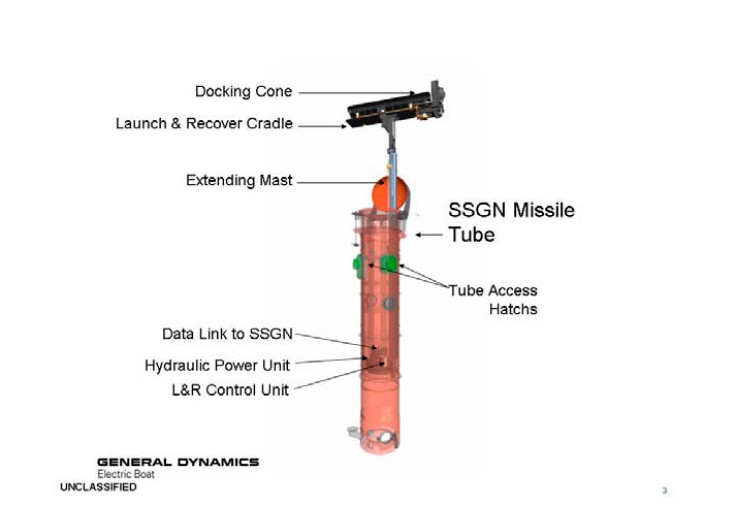
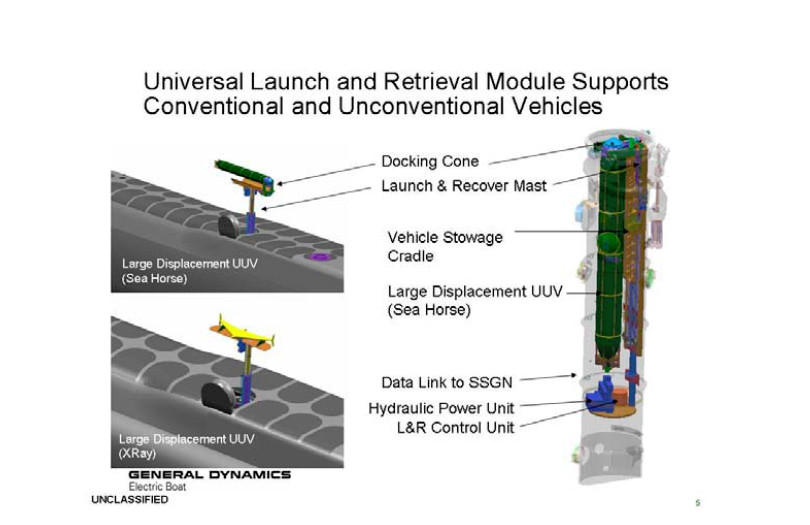
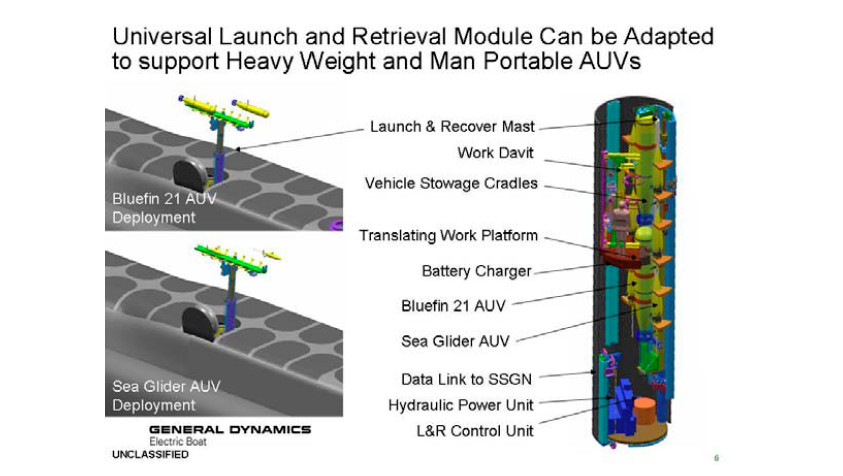
General Dynamics Electric Boat did not specifically say that this system could launch unmanned aircraft from submarines, but it is possible that it could have been adapted to deploy encapsulated drones. The same system might similarly be able to deploy other payloads, as well, such as mines or decoy balloons.
As it was working on the ULRM, the company also said that it was developing an improved storage module that would be more readily transportable and installable. This, in principle, would have allowed more tailored special operations force packages to rapidly deploy to a forward port to rendezvous with one of the submarines for a specific mission.
There was also talk about another module that could contain additional masts with sensors or potentially for deploying additional payloads, such as drones. The modular nature of these systems combined with the large number of missile tubes on the SSGNs offered the potential to readily mix and match capabilities that would be best suited to the boat’s operational needs.
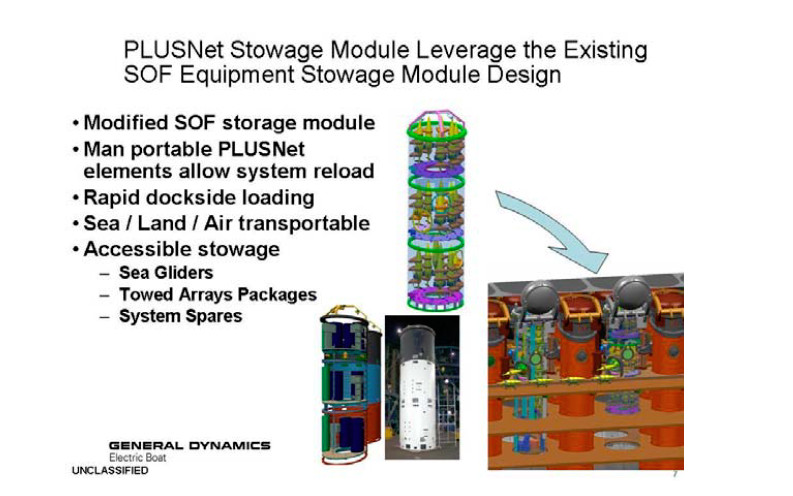
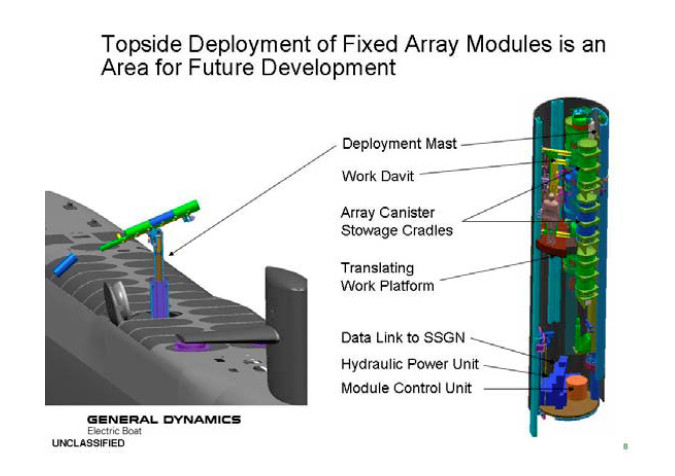
In 2013, the Navy said that it would test a prototype ULRM onboard one of the Ohio class SSGNs the following year. The goal at that time was to have examples available for actual operational use by 2019, but it’s unclear if this has occurred or not.
Upward Falling Payloads And Hydra
In 2013, DARPA itself initiated a new program to explore the possibility of launch small unmanned aircraft from capsules that could lie on the seabed, dormant and potentially unknown to potential opponents, for years at a time. A submarine could potentially deploy them covertly, as well, a mission that seems well suited to the SSGN concept of operation.
Known as Upward Falling Payloads (UFP), this project envisioned a system that American forces could activate remotely, or that might be triggered automatically in some fashion, and then release its payload. “Such a system of pre-positioned, deep-sea nodes could enable a full range of maritime mission sets that are more cost-effective than existing manned or long-range unmanned naval assets,” DARPA’s archived page for the project explains. UFP is also reminiscent of the Broaching Universal Buoyant Launcher (BUBL) system from a decade earlier, but it’s not clear if there is any actual direct relationship between the two projects.

At the same time, DARPA was working on this seabed payload launcher concept, it was also exploring a modular, standardized payload module that could work with submarines, as well as aircraft and surface ships, called Hydra. This could deploy either unmanned aircraft or UUVs and sounds similar in some respects to the Stealthy Affordable Capsule System (SACS). Again, it is unclear if there was any direct relationship between these two efforts.
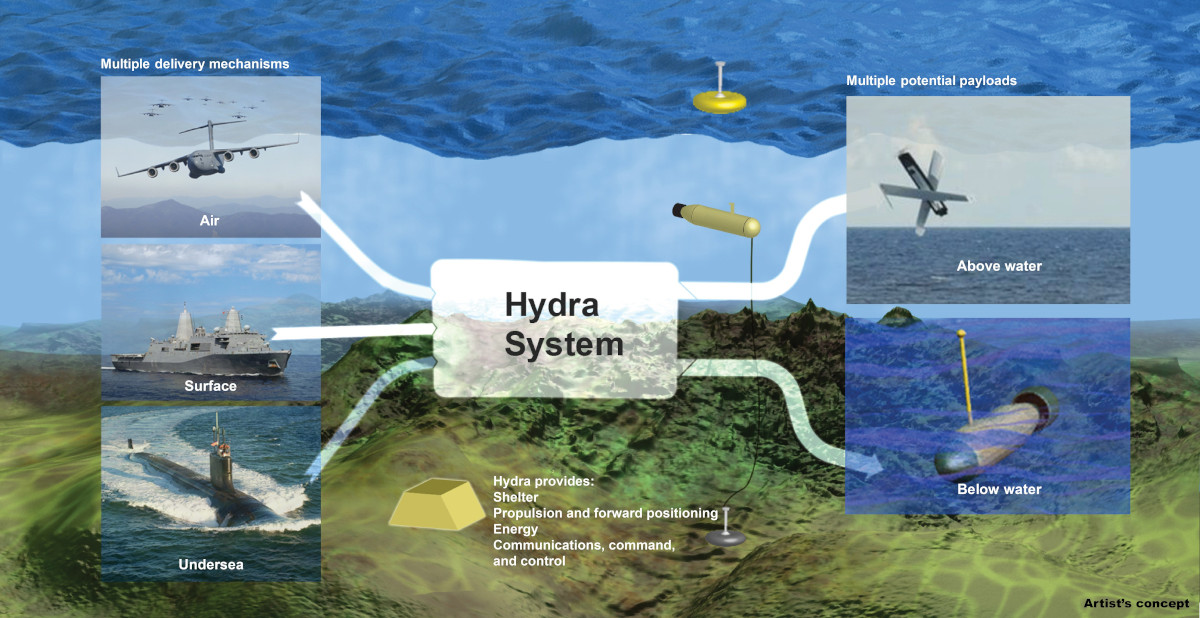
Both UFP and Hydra appear to have come to an end sometime between 2016 and 2017. As with Cormorant, it’s not immediately clear if these continued on in some other form, including in the classified realm.
In 2013, the Navy itself had successfully demonstrated the ability to launch an encapsulated unmanned aircraft via a submarine’s torpedo tube. The Los Angeles class USS Providence (SSN-719) deployed the Naval Research Laboratory’s eXperimental Fuel Cell Unmanned Aerial System, or XFC UAS, using a launch system known as Sea Robin, which used a modified Tomahawk missile launch canister. That same year, the service said it was also actively testing AeroVironment’s Blackwing using the standard three-inch countermeasures launchers on its submarines.
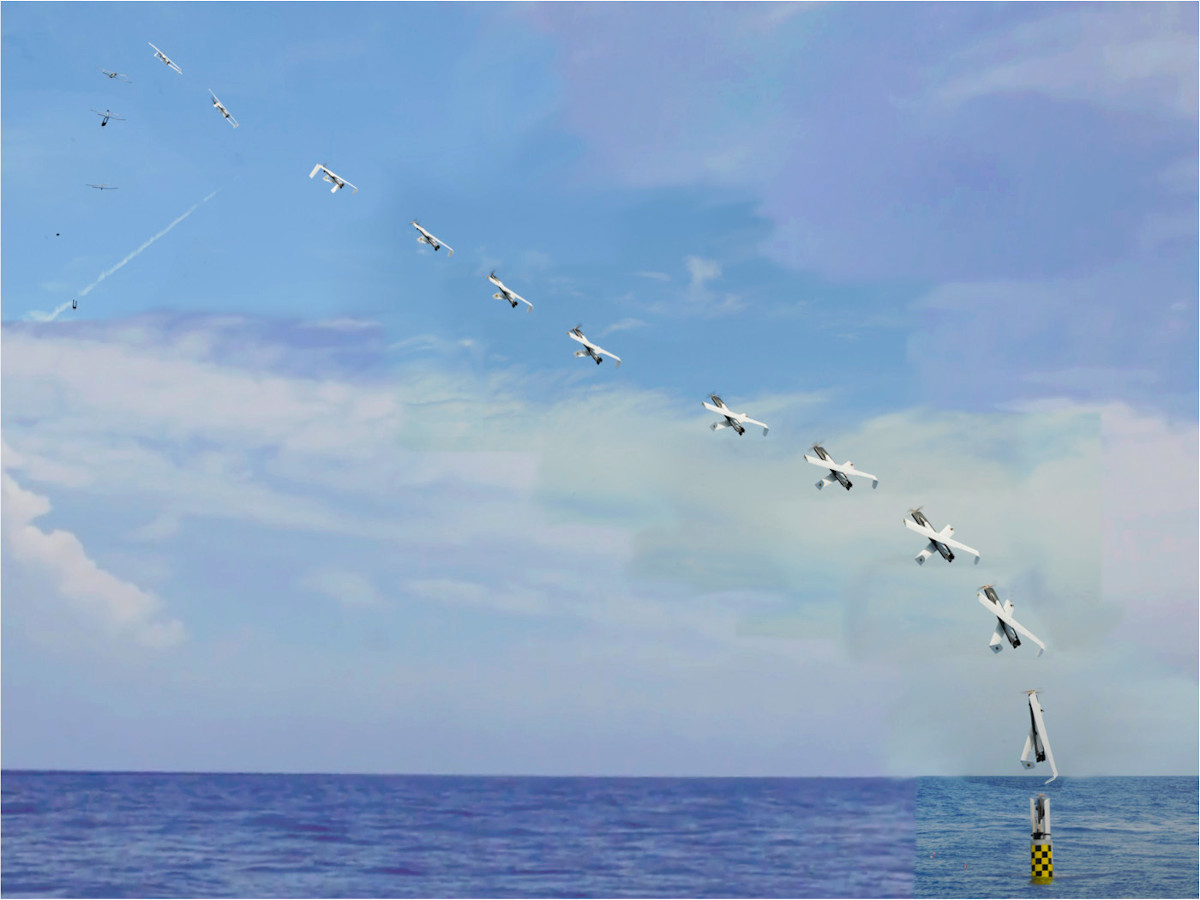
More capable than we know
All told, it seems very possible, if not probable, that the capabilities of the Ohio class SSGNs have significantly expanded since Silent Hammer in 2004, even if the specifics are limited. Even without new systems, such as the Universal Launch and Recovery Module, the Ohio SSGNs have already been using their modified Trident launch tubes to deploy unmanned systems and for other novel purposes, including just acting as valuable storage space within the confines of the submarines.
The intelligence collection and fusion systems that Georgia had in 2004, even before its full conversion into the SSGN configuration, were state-of-the-art. More than a decade of improvements in basic computing technology and processing power, as well as new developments in data links and communications systems, including new ways for submarines to transmit and receive information, can only have drastically expanded those already impressive capabilities.
UUV and drone technology has also come a long way, both in general and within the Navy specifically. The service, by itself, has made significant progress in submarine-launched drones, drone swarm technology, and autonomous capabilities that apply to unmanned platforms in the air, at sea, and underneath the waves. Just this year, the Navy hired Boeing to build a new fleet of large displacement UUVs as part of a program called Orca, which you can read about in more detail in this past War Zone piece. All of this aligns well with the SSGN’s capabilities, and the Navy’s long-standing plans to expand them, as we understand it.

The Navy has also been quietly working on a new and revolutionary electronic warfare architecture, known as the Netted Emulation of Multi-Element Signature against Integrated Sensors, or NEMESIS, since at least 2013. The service has described this effort, which you can read about in-depth in this past War Zone feature, as involving swarms of unmanned platforms, various systems on ships and submarines, countermeasures and electronic warfare suites, and more that could combine to project signatures mimicking large groups of aircraft, surface ships, and subs.
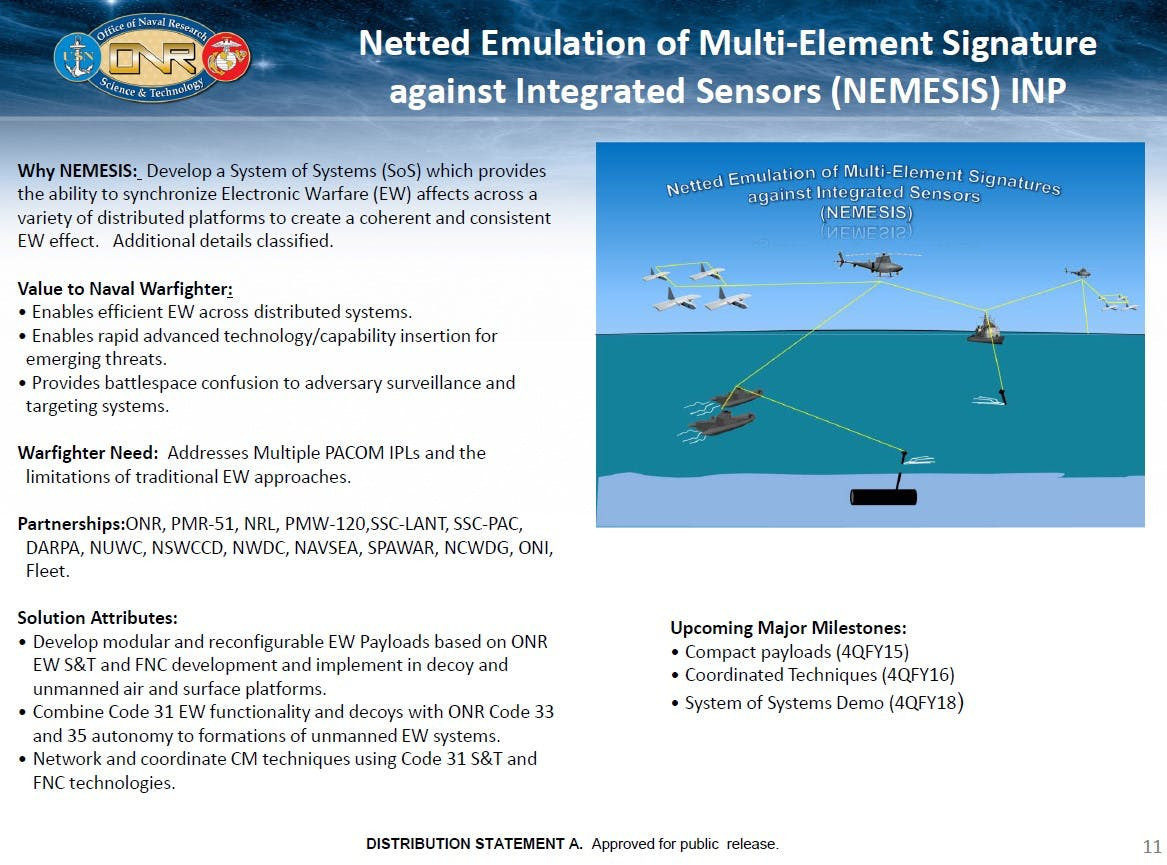
The Ohio SSGNs present an ideal platform for deploying elements of and supporting this cutting-edge and critical initiative. Most notably, they could launch swarms of small electronic-warfare payload-carrying drones deep in enemy territory that can project false fleets and aerial armadas on enemy sensors and act as decoys during a time of war or probe and gather intelligence on enemy air defense networks during a time of peace. Launching radar-reflector carrying balloons, a 60-year-old proven tactic, could also be part of this capability. In fact, we know of no better platform to carry out such a task.
The Ohio SSGNs could also see the integration of new conventional weapons to support their time-sensitive strike mission, and otherwise expand their offensive capabilities, in the future, as well. The Navy is already working on a number of new and upgraded missiles that could have submarine-launched applications, such as the multi-purpose SM-6 Block IB, a highly classified supersonic anti-ship missile known as Sea Dragon, and the future Next Generation Strike Weapon. The Navy has also already test-fired prototype submarine-launched hypersonic boost-glide vehicles from Ohio class submarines under the Conventional Prompt Strike program, though it’s unclear if it may choose to deploy those only on those submarines configured as SSBNs.
Smaller weapons could dramatically increase the boats’ already impressive magazine depth. The extra capacity could give the submarines more diversity in their arsenals, allowing them to engage broader target sets, as well. European missile consortium MBDA’s SPEAR 3 mini-cruise missile and its SPEAR-EW variant, which carries an electronic warfare payload instead of a warhead, are good examples of the kind of miniaturized missiles that could be extremely valuable additions to the Ohio SSGNs.
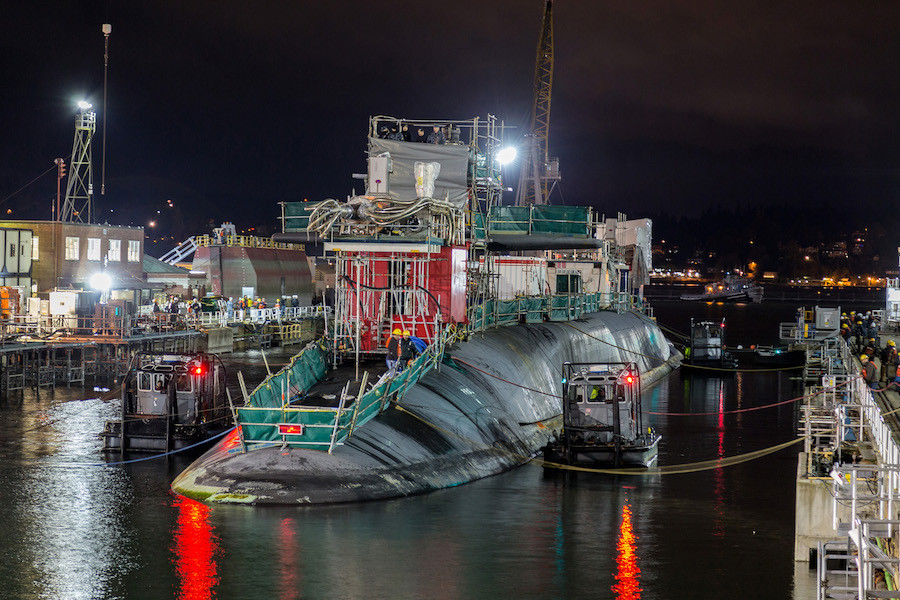
The Navy has also been putting these converted Ohios through major refits, which serve as an opportunity to integrate even more new capabilities. Georgia left the dry dock at Naval Submarine Base Kings Bay in March 2019 and Ohio
finished her stint at the Puget Sound Naval Shipyard & Intermediate Maintenance Facility in Washington State in August. Michigan is set to return to the fleet in 2020. It is not clear when Florida, which is presently deployed in the Mediterranean, will go through the process. These overhauled SSGNs likely represent a whole new level of capability derived from lessons learned over the last decade and a half of operations.

Successors to the Ohio SSGNs
Unfortunately, the Ohios SSGNs won’t be able to serve forever, they are already the oldest Ohio class submarines in existence, and the Navy is already exploring concepts for what comes next. The experience with these four boats has directly informed the development of the Virginia Payload Module (VPM) for the future Block V Virginia class attack submarines.
The VPM has four large multi-purpose tubes that can accept various modules just like the modified Trident missile tubes on the Ohio SSGNs, including the same seven-round Tomahawk launchers. The designs of the existing Block III and future Block IV Virginia class boats also already feature two similarly-sized Virginia Payload Tubes (VPT) in the bow of the submarine.
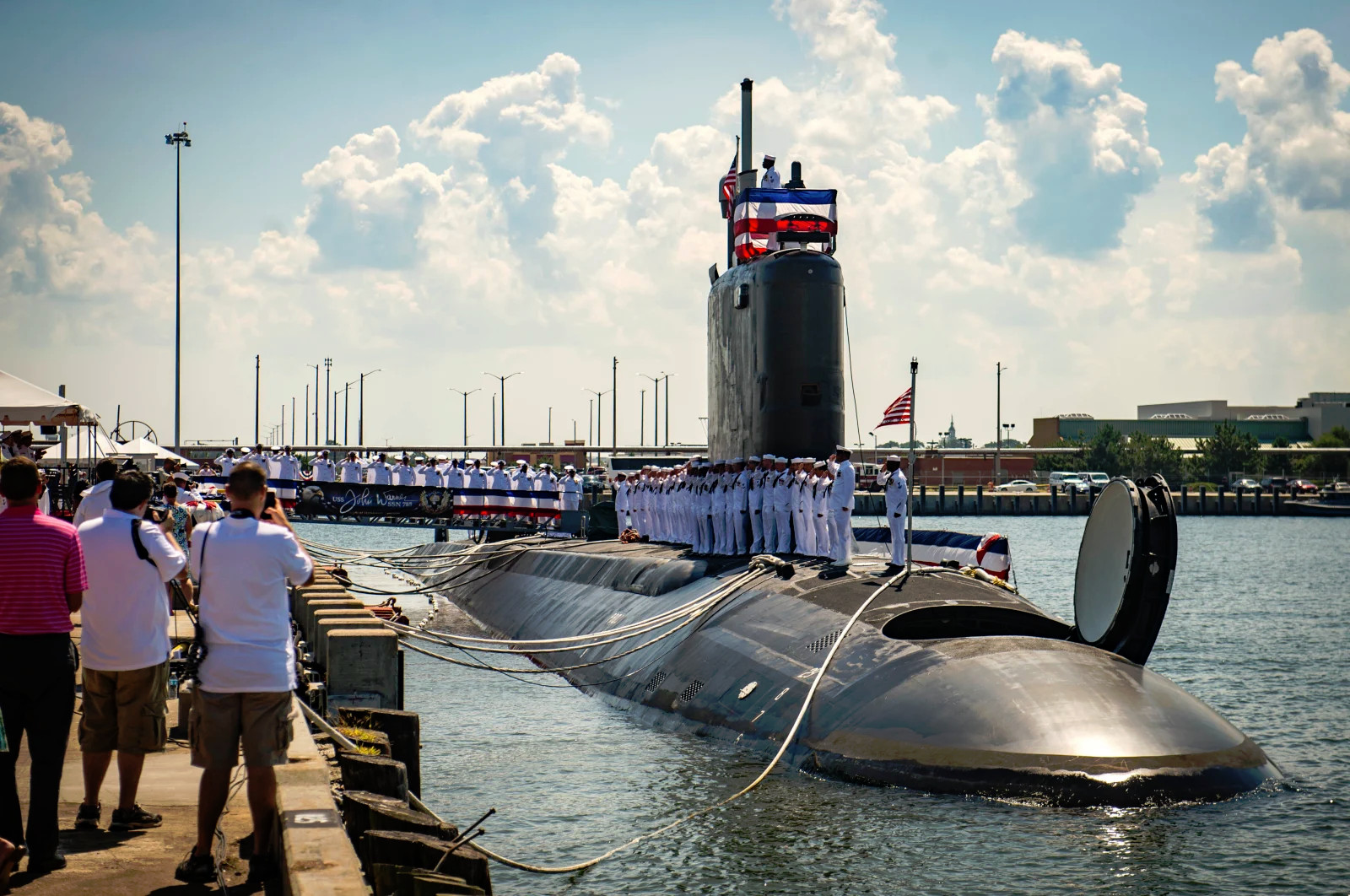
As such, the VPTs already bring some of the multi-mission capability found on the SSGNs to the Block III Virginias and this will only be more pronounced on the Block IV boats. The Navy has already set aside at least four Block II and III Virginia class submarines for special operations support missions, with two more available as alternates, if required.
These six Virginias – USS Hawaii, USS Mississppi, USS New Hampshire, USS New Mexico, USS North Carolina, and USS North Dakota – can also carry the same types of Dry Deck Shelters (DDS) as the Ohio SSGNs. All of these submarines actually share a common pool of DDSs that Navy personnel can install on any of the boats, as necessary.
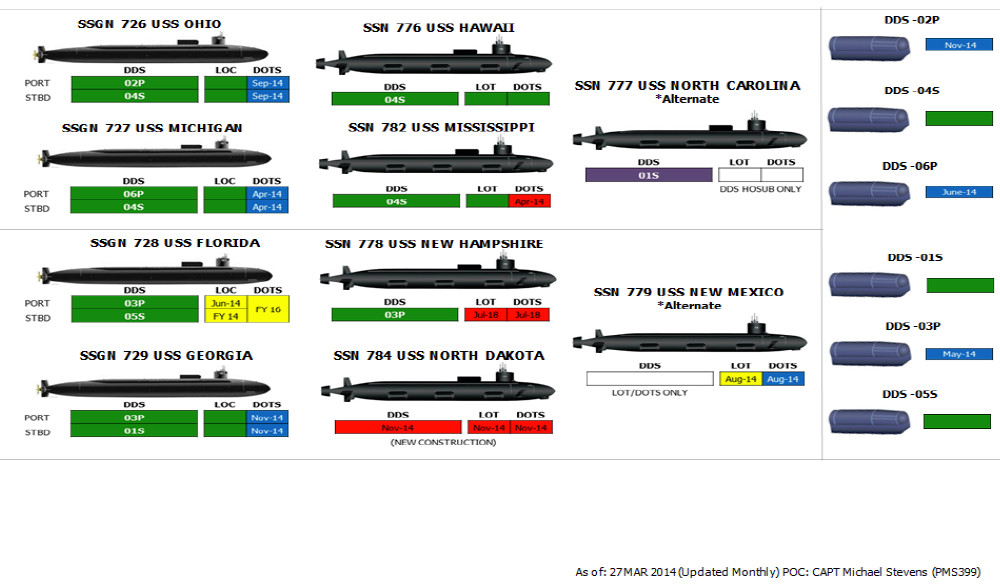
The Navy’s present plan is to fully replace the Ohio SSGNs with Block IV Virginias by 2026, though, especially given the recent refits, its possible that the former boats could end up remaining in service longer. It’s not clear whether older Virginias would continue to serve int he special operations support role, as well.
Beyond that, the Navy is already exploring options for what it presently refers to as Large Payload Submarines, which will be a future class of multi-purpose, multi-mission boats derived from the Columbia class SSBN design that will be capable of, as the name implies, deploying a wide variety of large payloads. This could include both UUVs and submarine-launched drones. The submarines could also have the ability to deploy networked swarms of these unmanned platforms above or below the waves.
At present, the Navy plans to buy a minimum of five Large Payload Submarines, but it’s not clear when they might actually enter service. The current schedule would be to buy one every three years starting in 2036, after the initial Columbia class production run, totaling 12 boats, ends.
However, there are already concerns about how expensive and complex the Columbias are, each of which will cost more than $7 billion, and whether General Dynamics Electric Boat and Newport News Shipbuilding will be able to keep to the schedule. This, in turn, could push plans for the Large Payload Submarines further into the future. You can read more about all this in-depth in this past War Zone story.
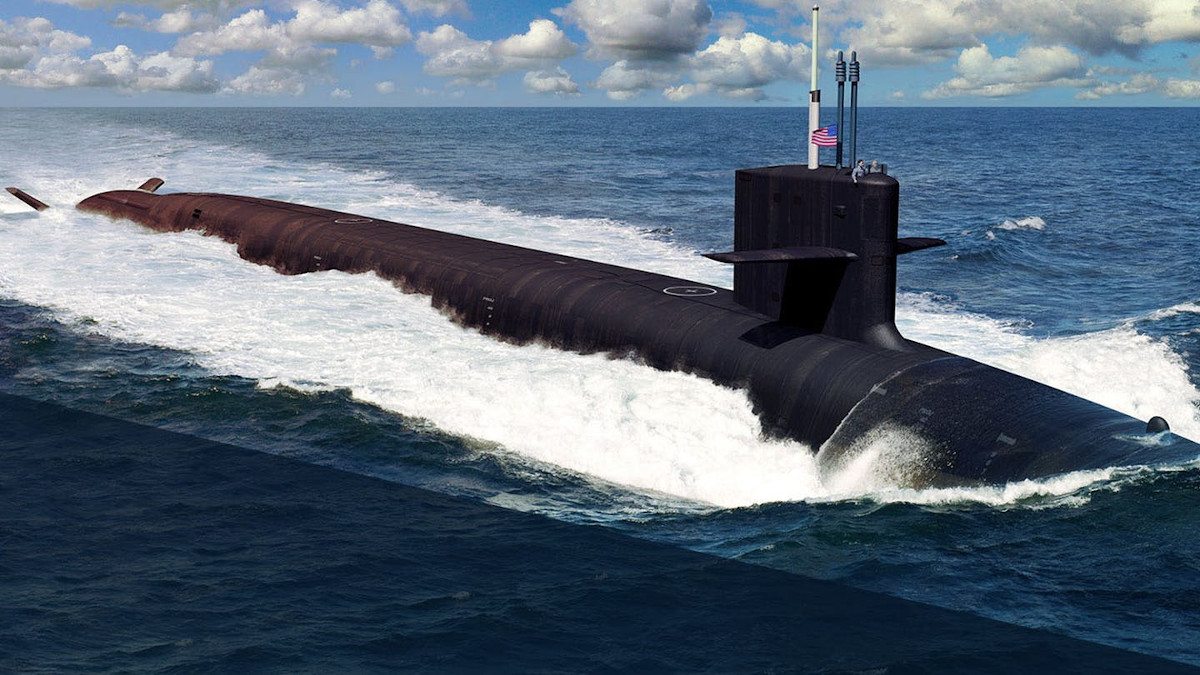
More than 15 years after Georgia wrote the first few chapters in the book on Ohio class SSGN concepts of operations, the U.S. Navy’s four SSGNs remain some of the most unique and capable platforms within the Pentagon’s portfolio, and that is just based on what we know about their abilities. By every indication, these submarines have and continue to serve as testbeds for even more impressive developments that still have yet to become public.
Just think, if the ability to launch various drones, both air and sea types, and especially higher-end ones like the Skunk Works’ Cormorant, was very much in development on multiple fronts 15 years ago, just imagine what is deployed today or on the drawing board. If an SSGN can carry up to 154 Tomahawk missiles, how many small weaponized drones can it carry and how could an enemy ever defend against such an overwhelming onslaught crossing their shores? It is this type of imagination and the room to realize such dreams that have made these submarines so valuable and, for lack of a better term, revolutionary.
It’s safe to say that the Navy’s SSGNs are a case of “more than meets the eye,” as they are much more than the stealthy Tomahawk slingers and SEAL delivery platforms that the public perceives them to be. While their arsenal of cruise missiles and frogmen is certainly formidable, their ability to adapt, spy on the enemy, control the battle from under the waves, and above all else, accommodate new ideas, makes them uniquely ferocious to any enemy nation they may be sitting off of at any given moment.
Contact the author: joe@thedrive.com
